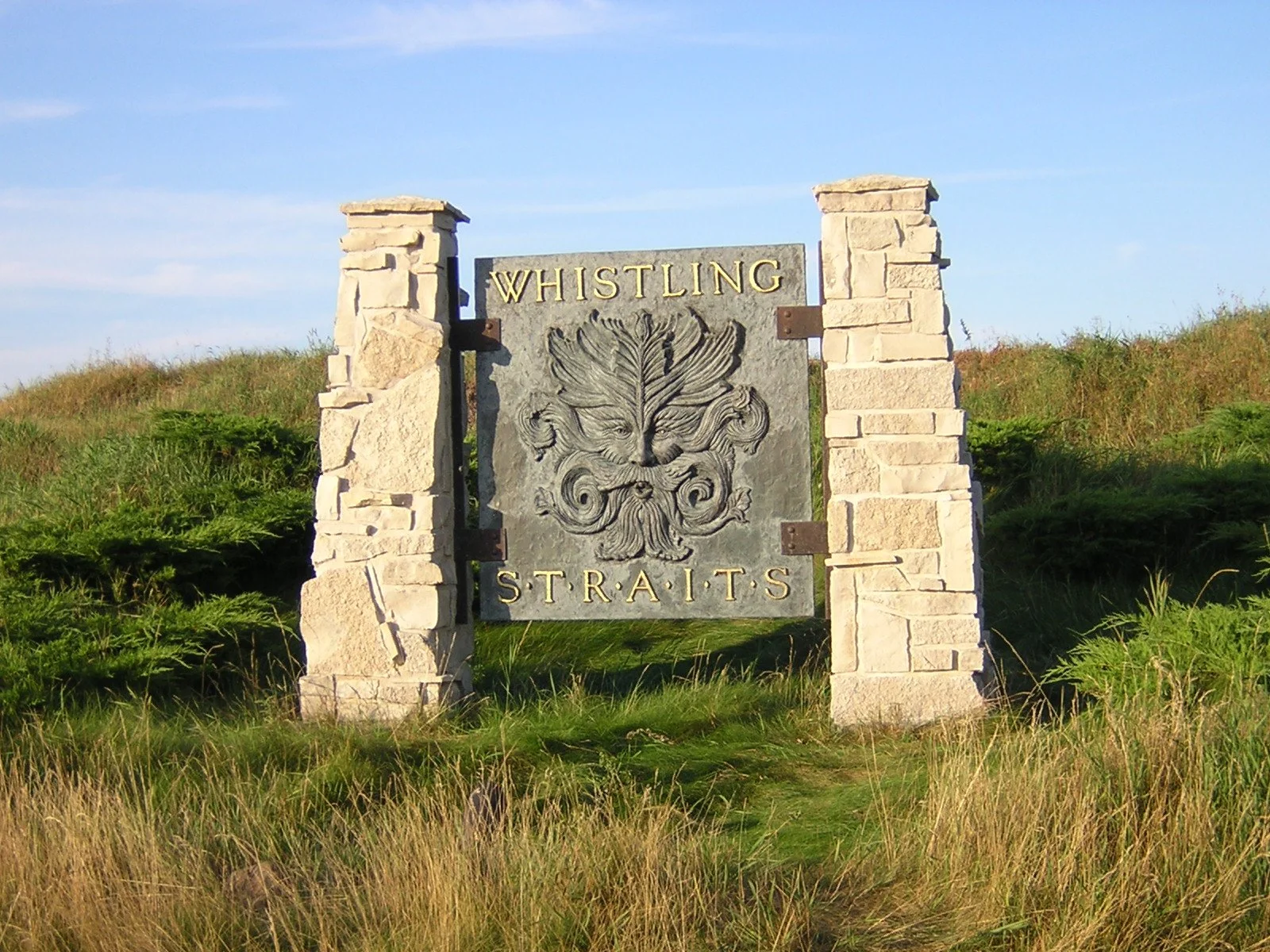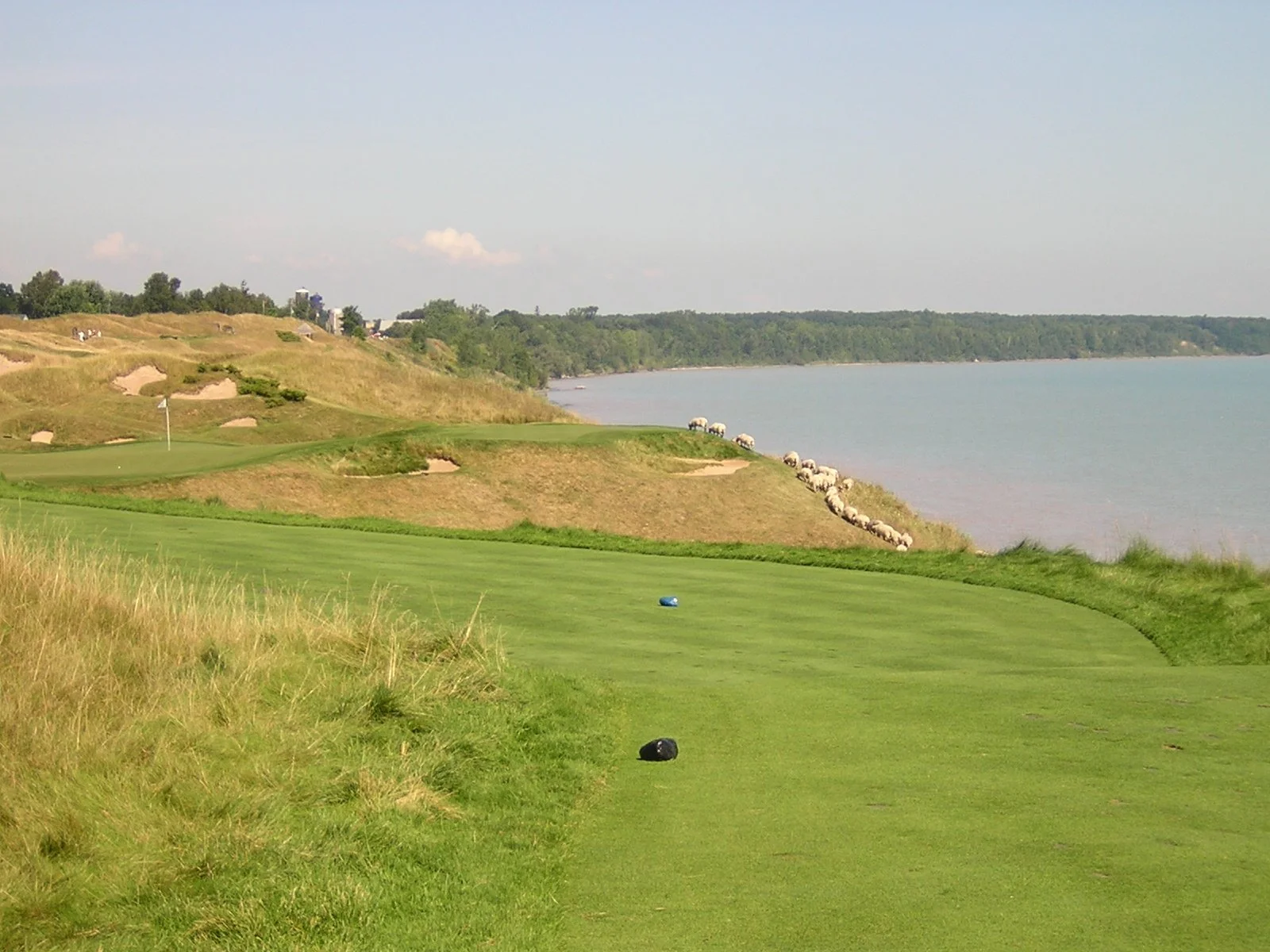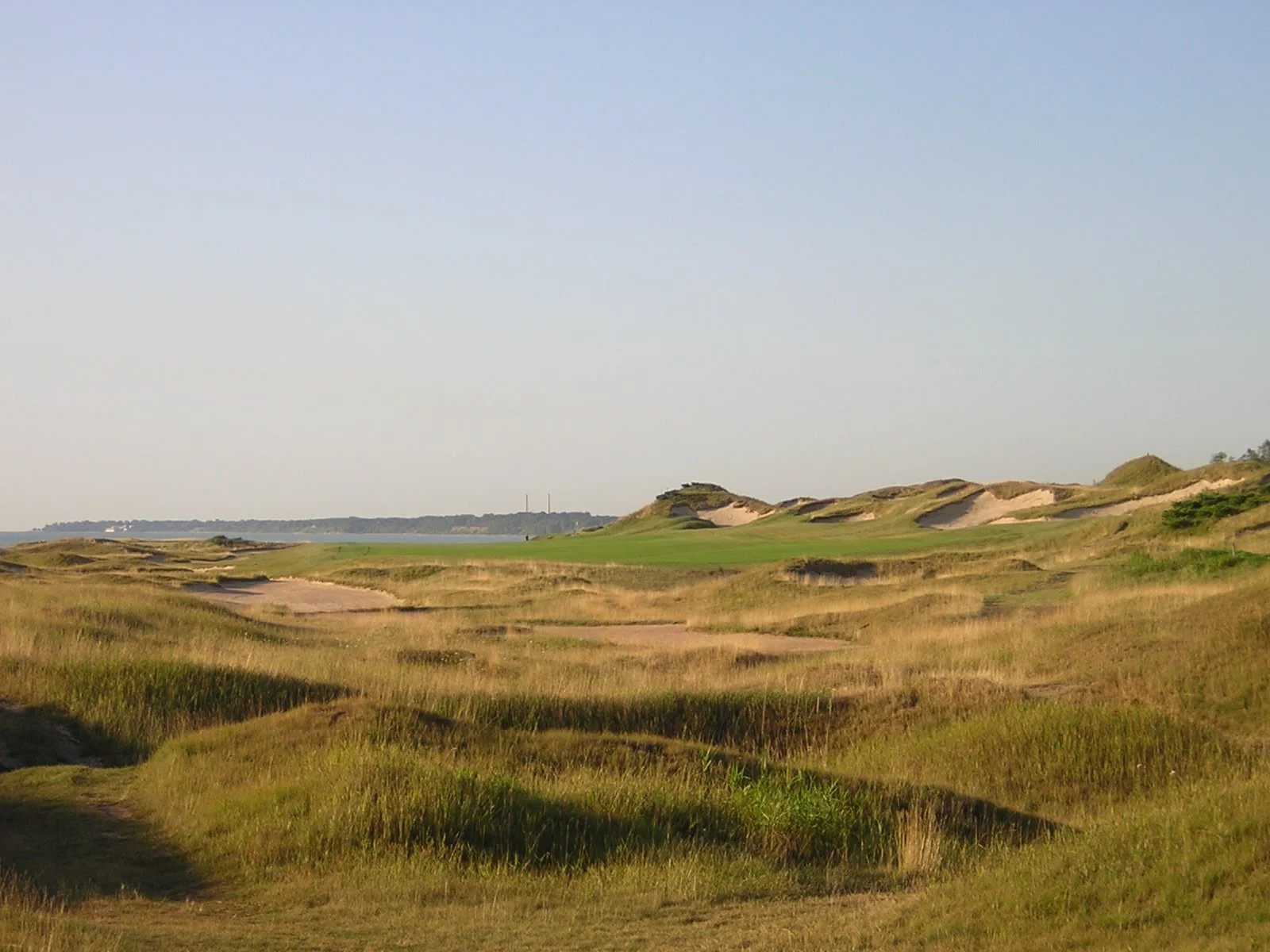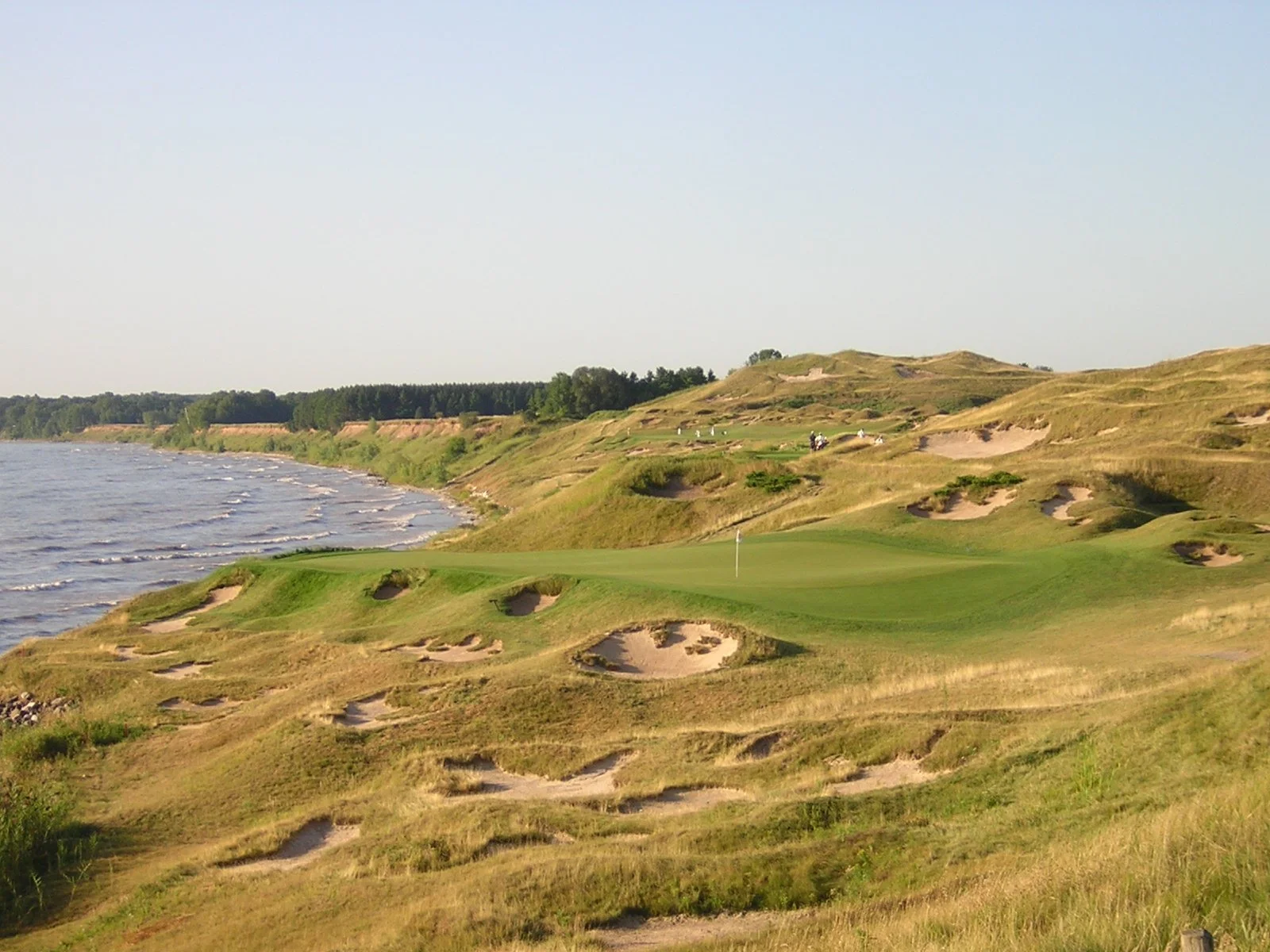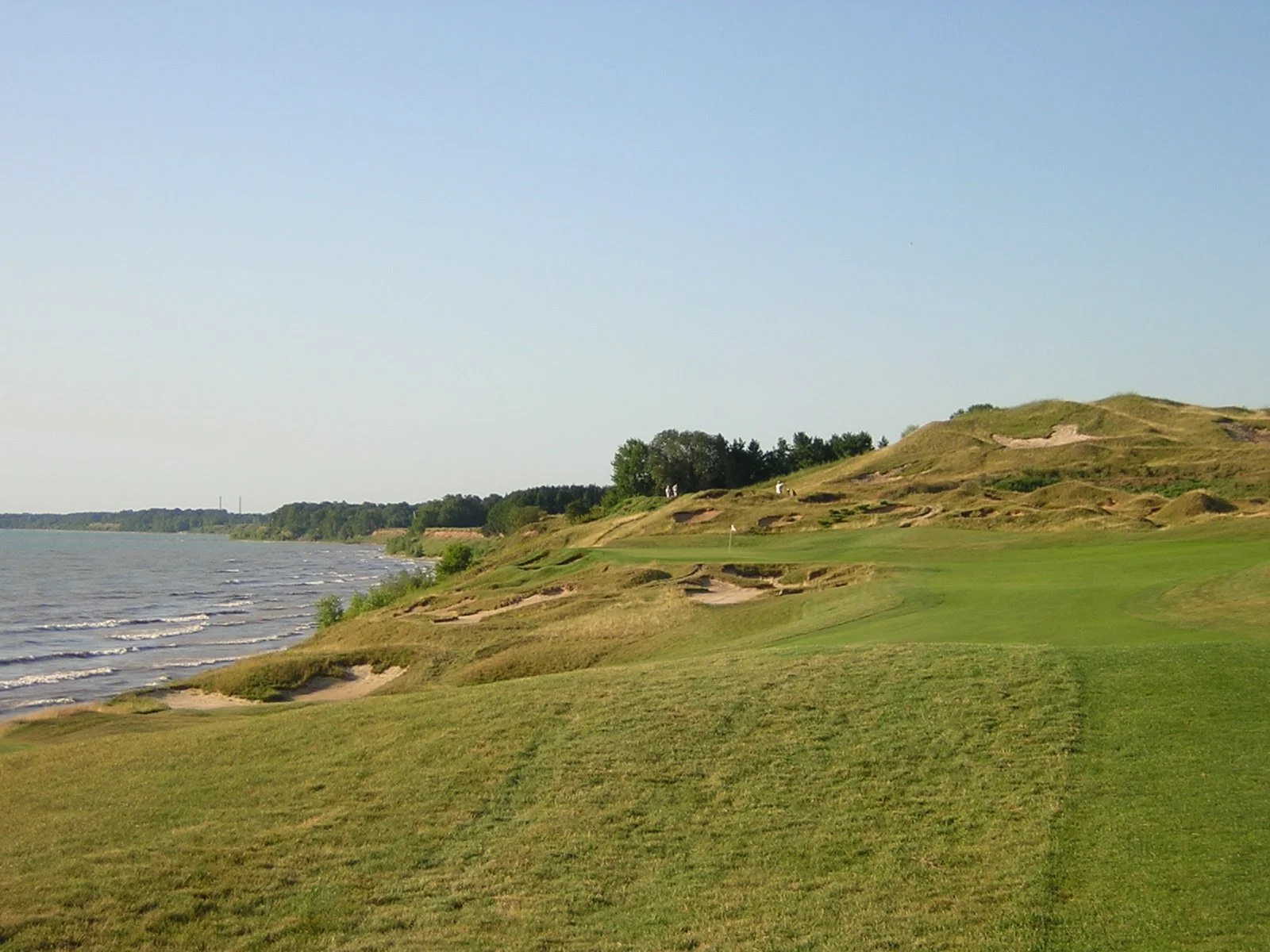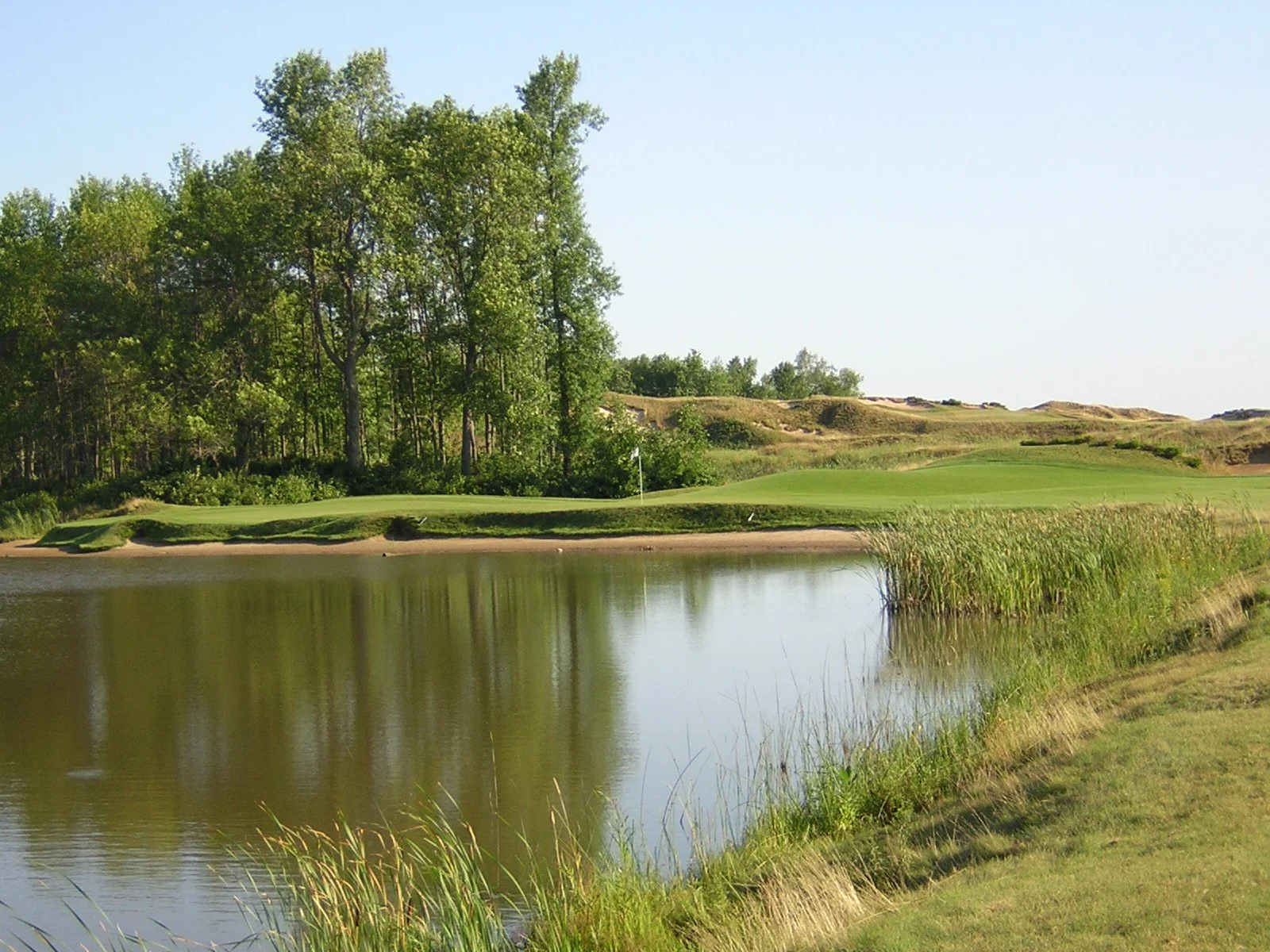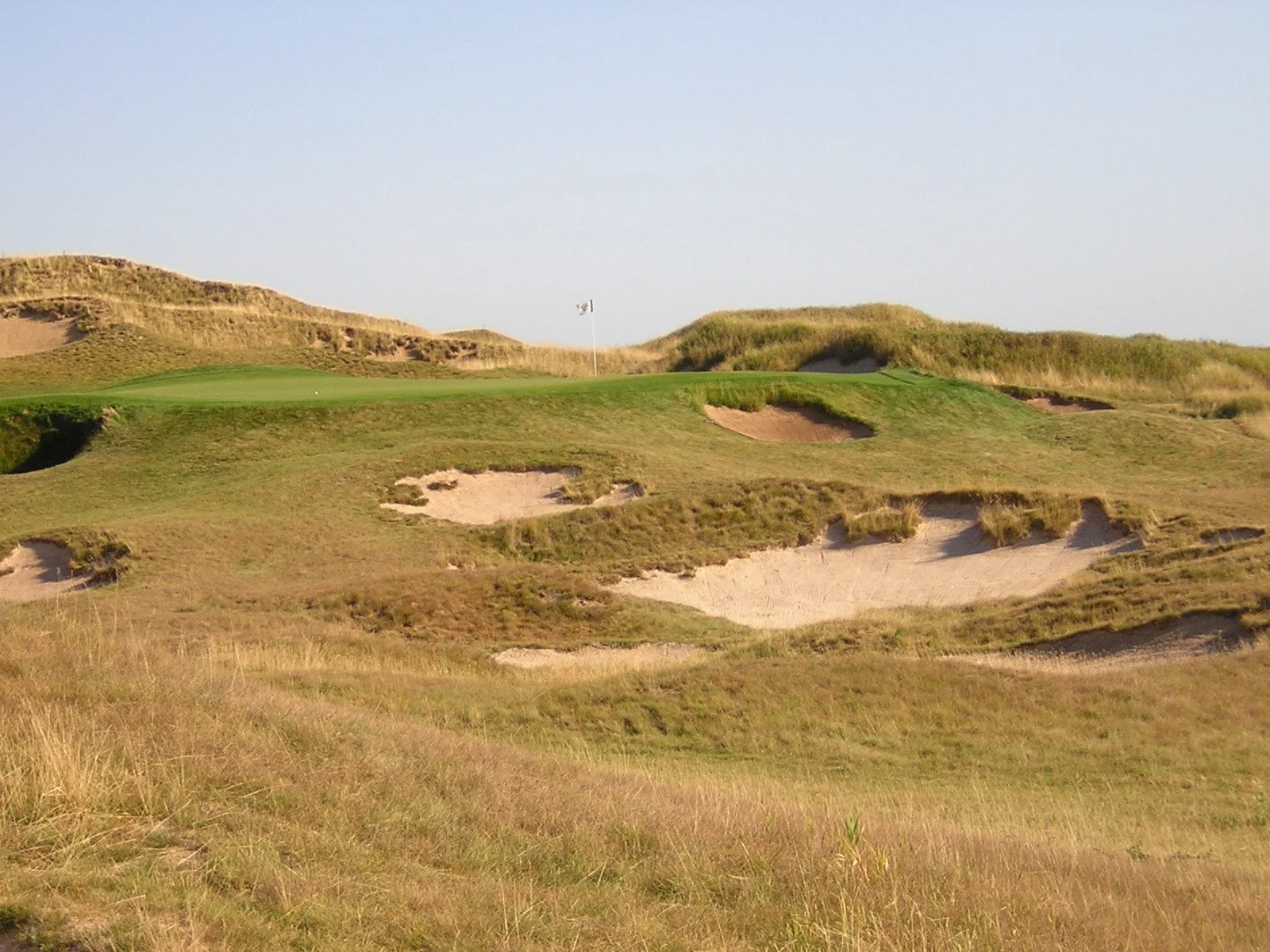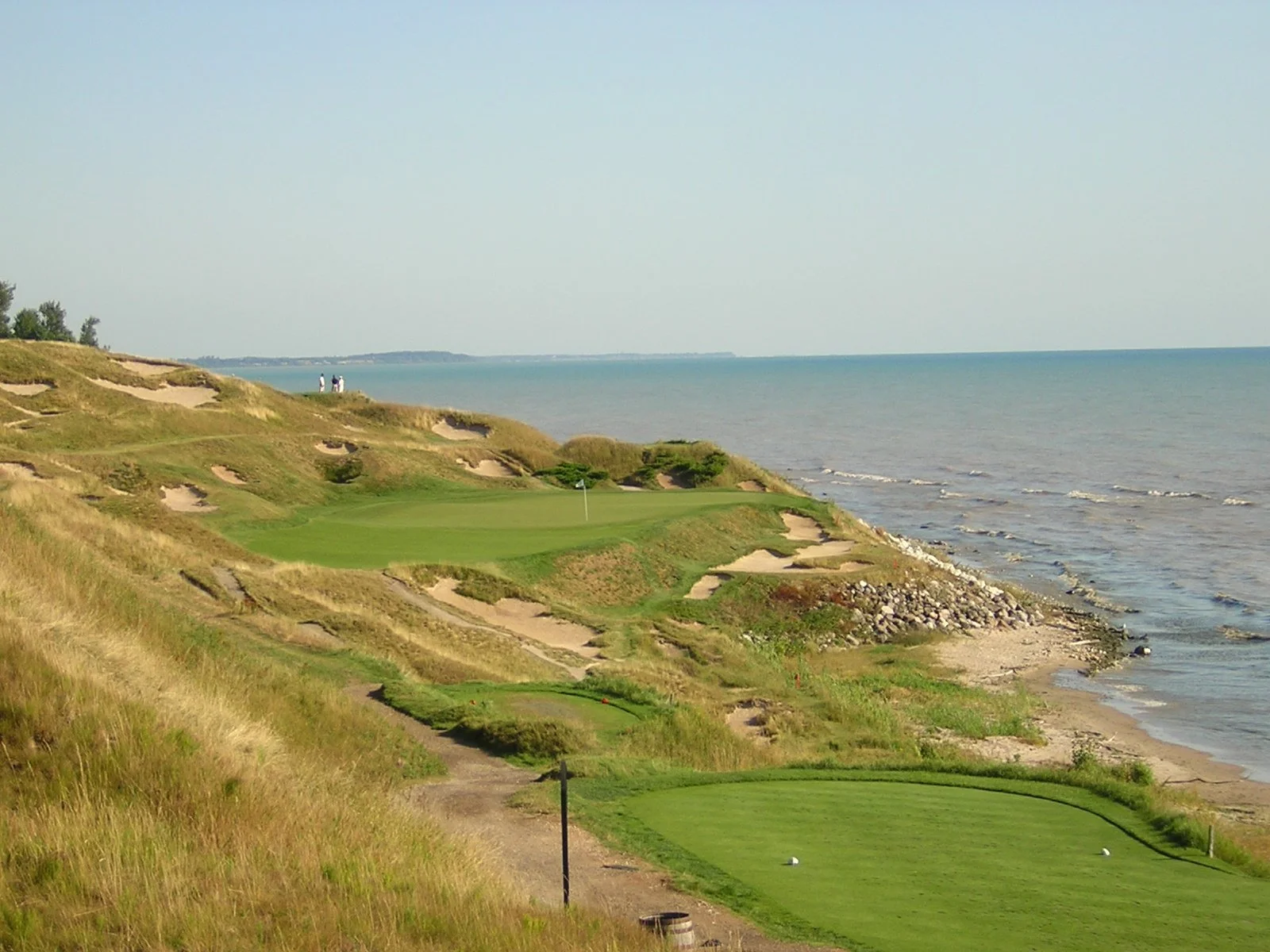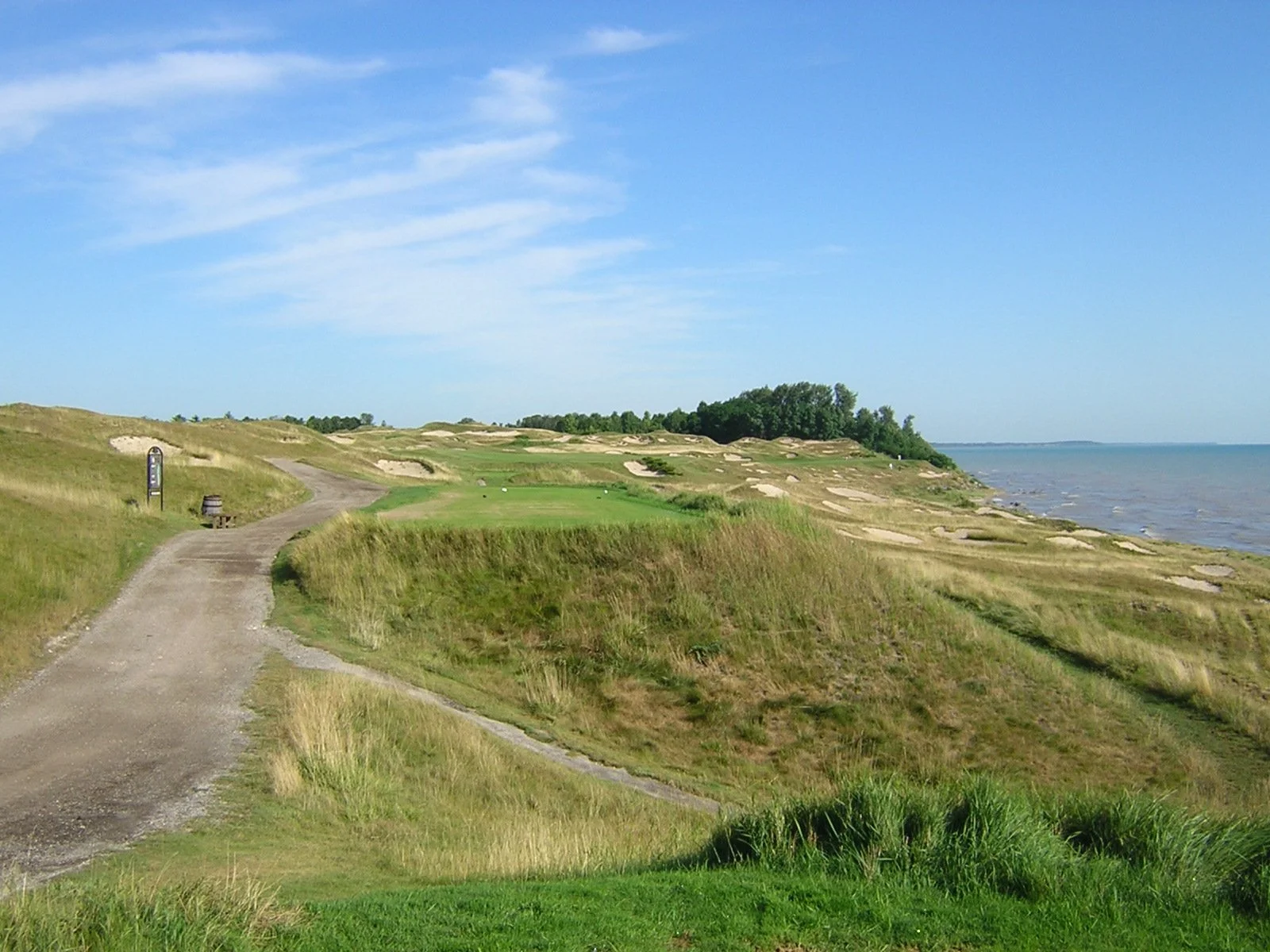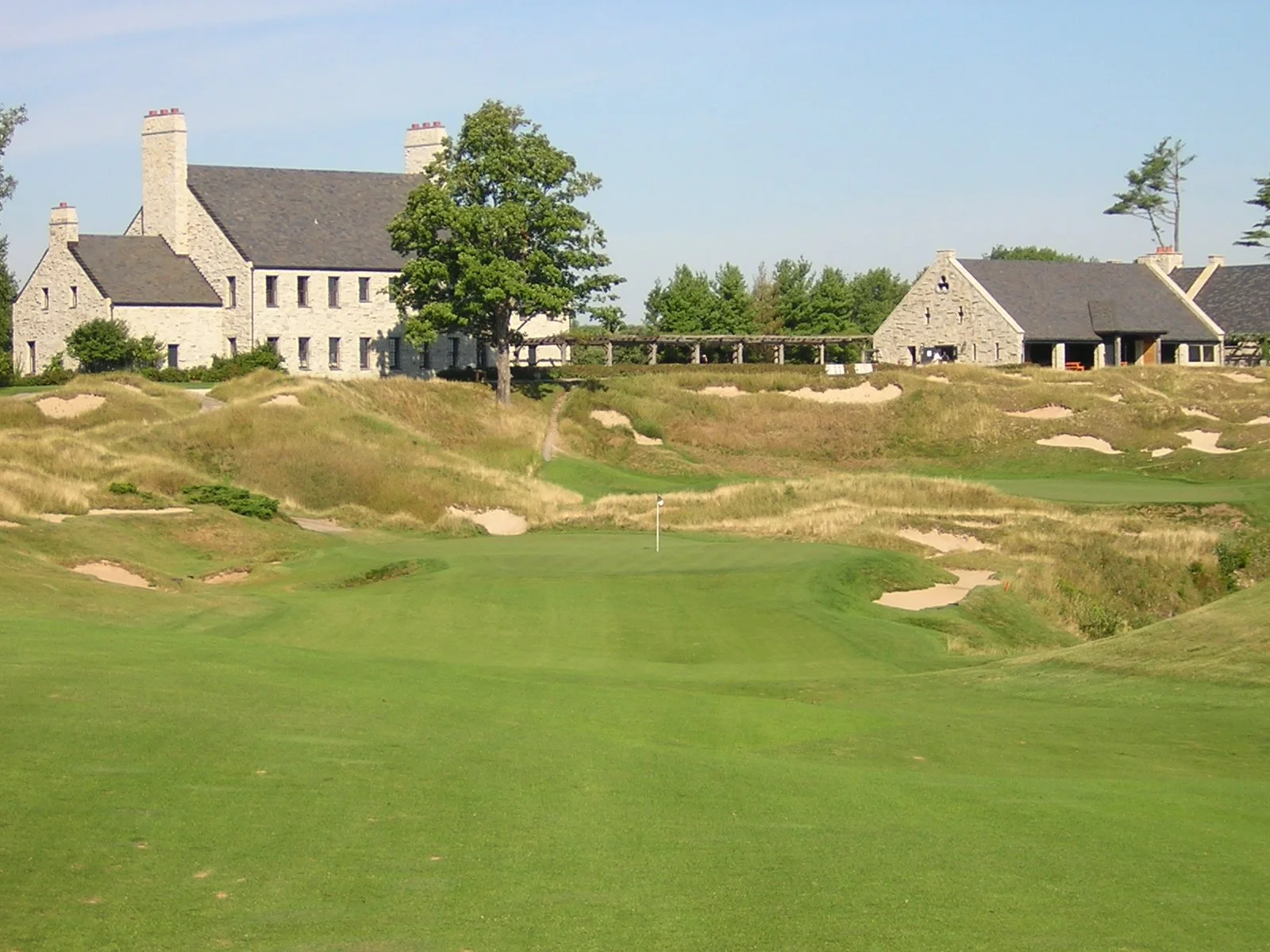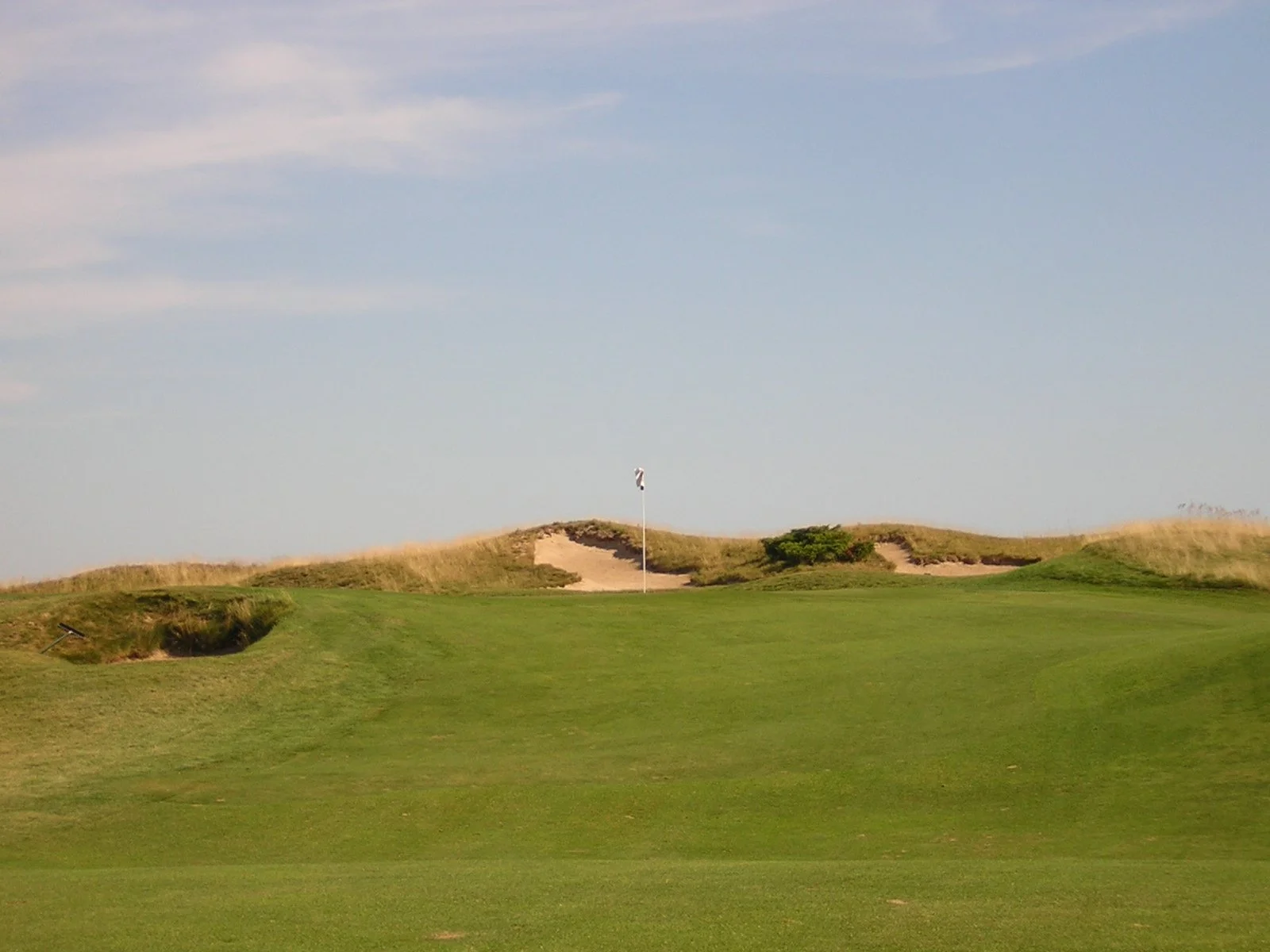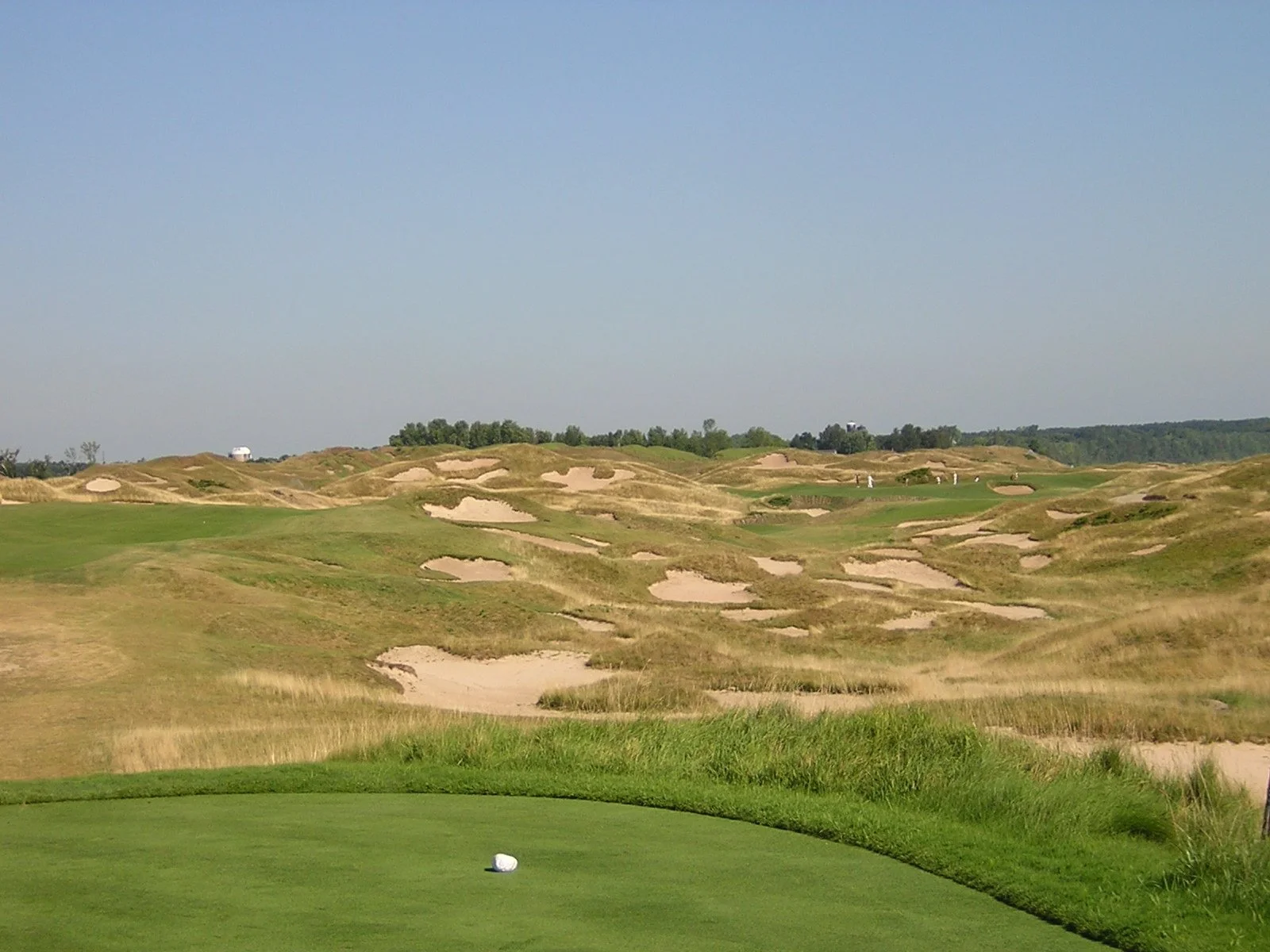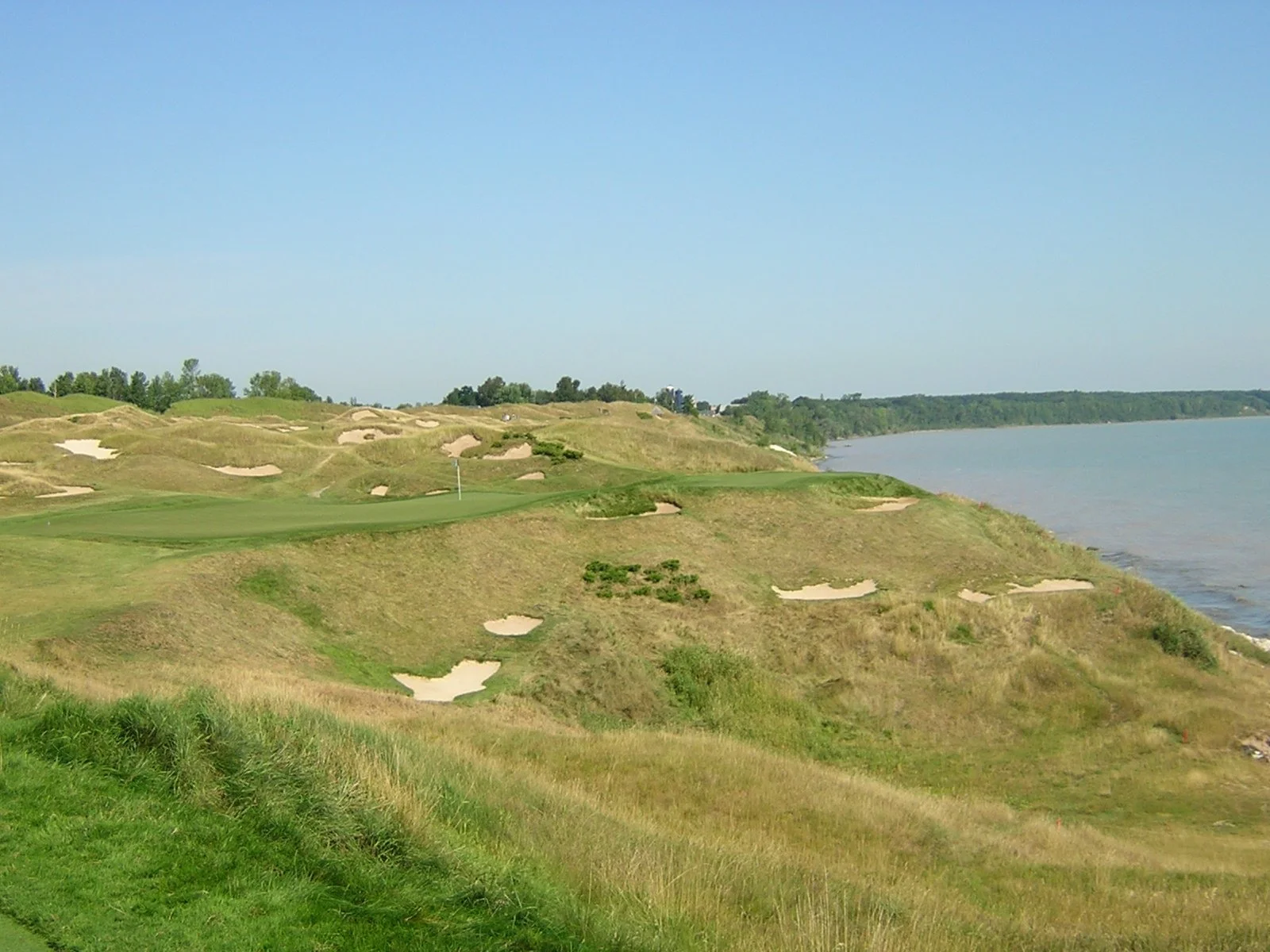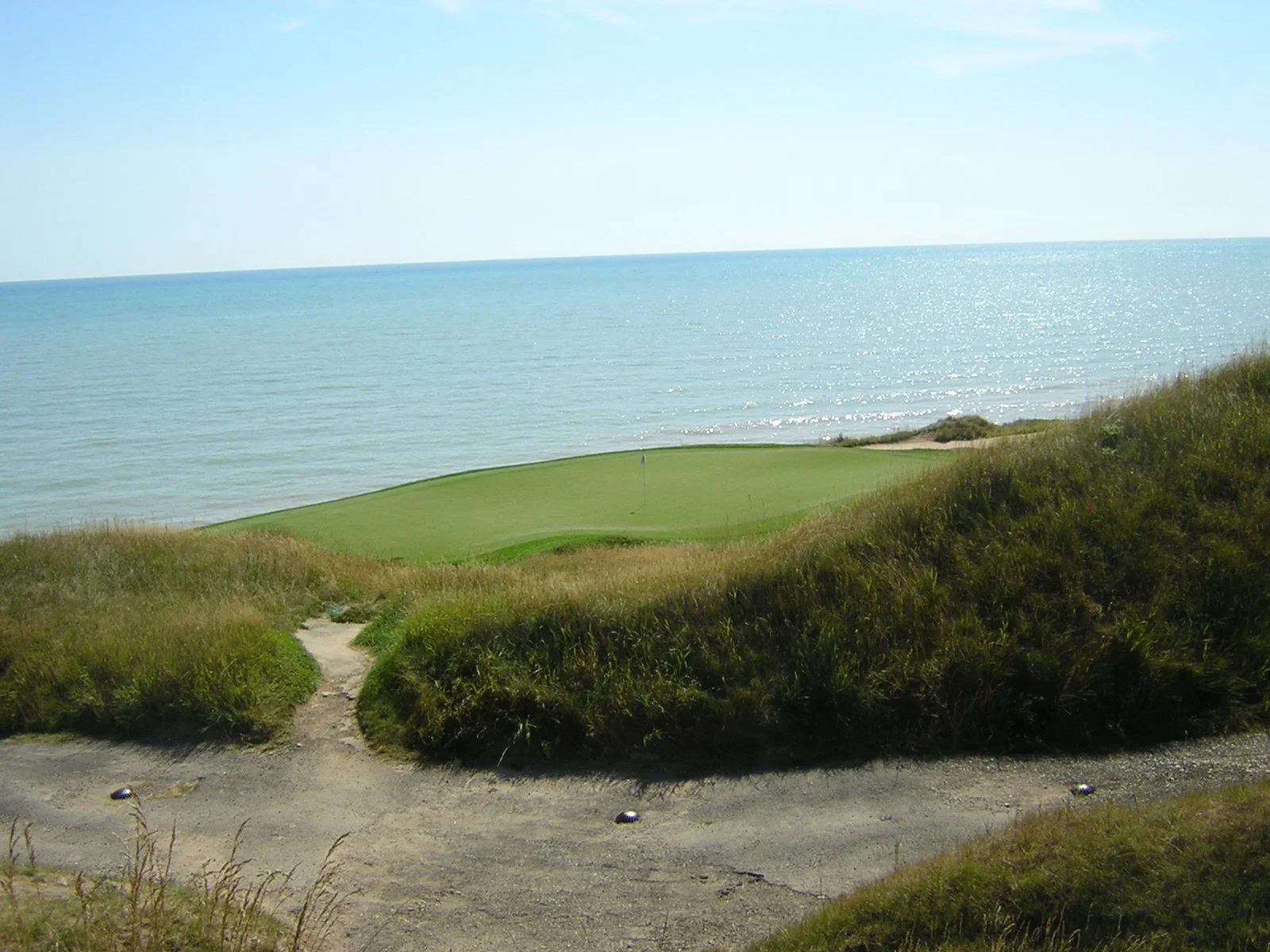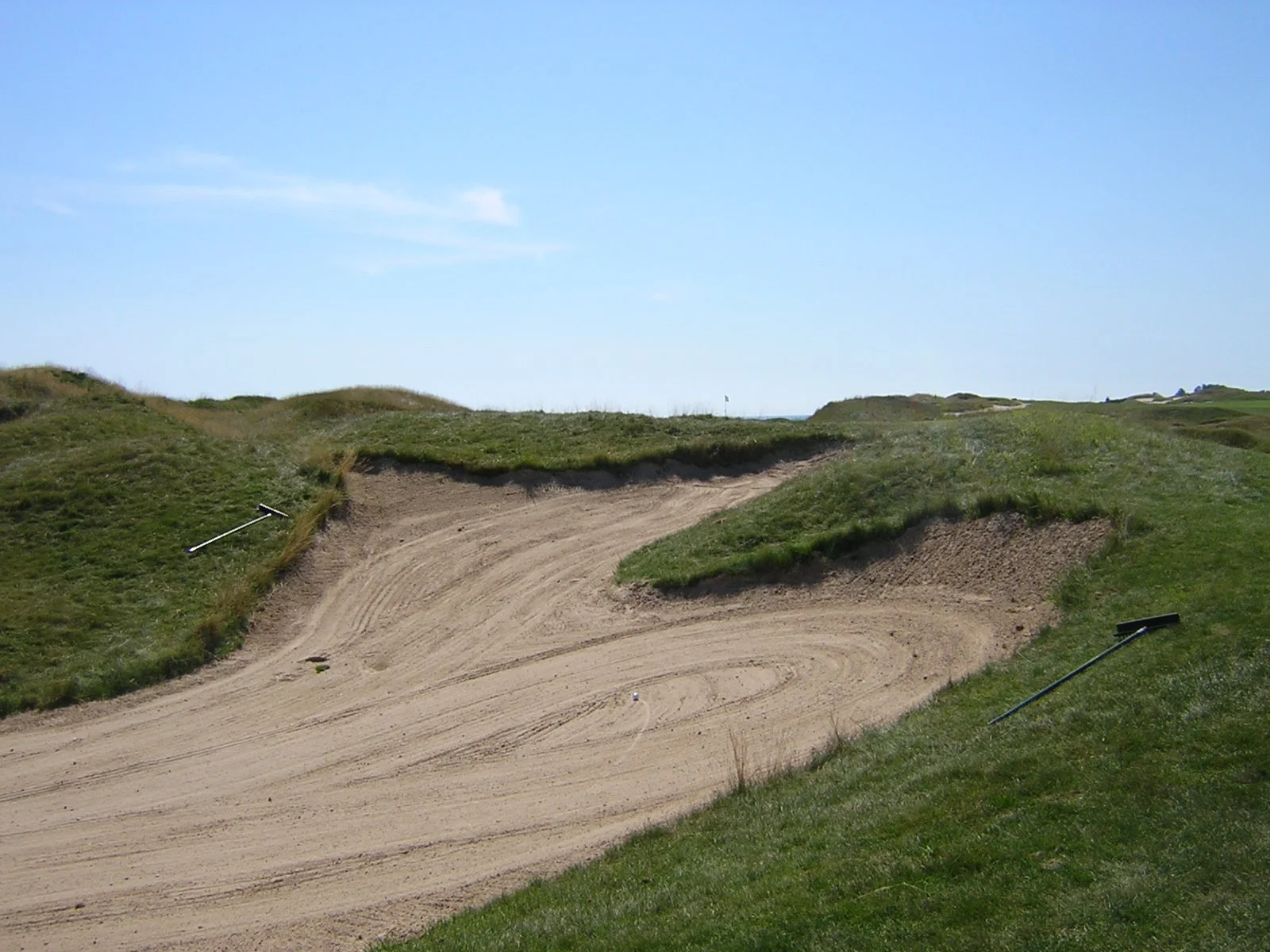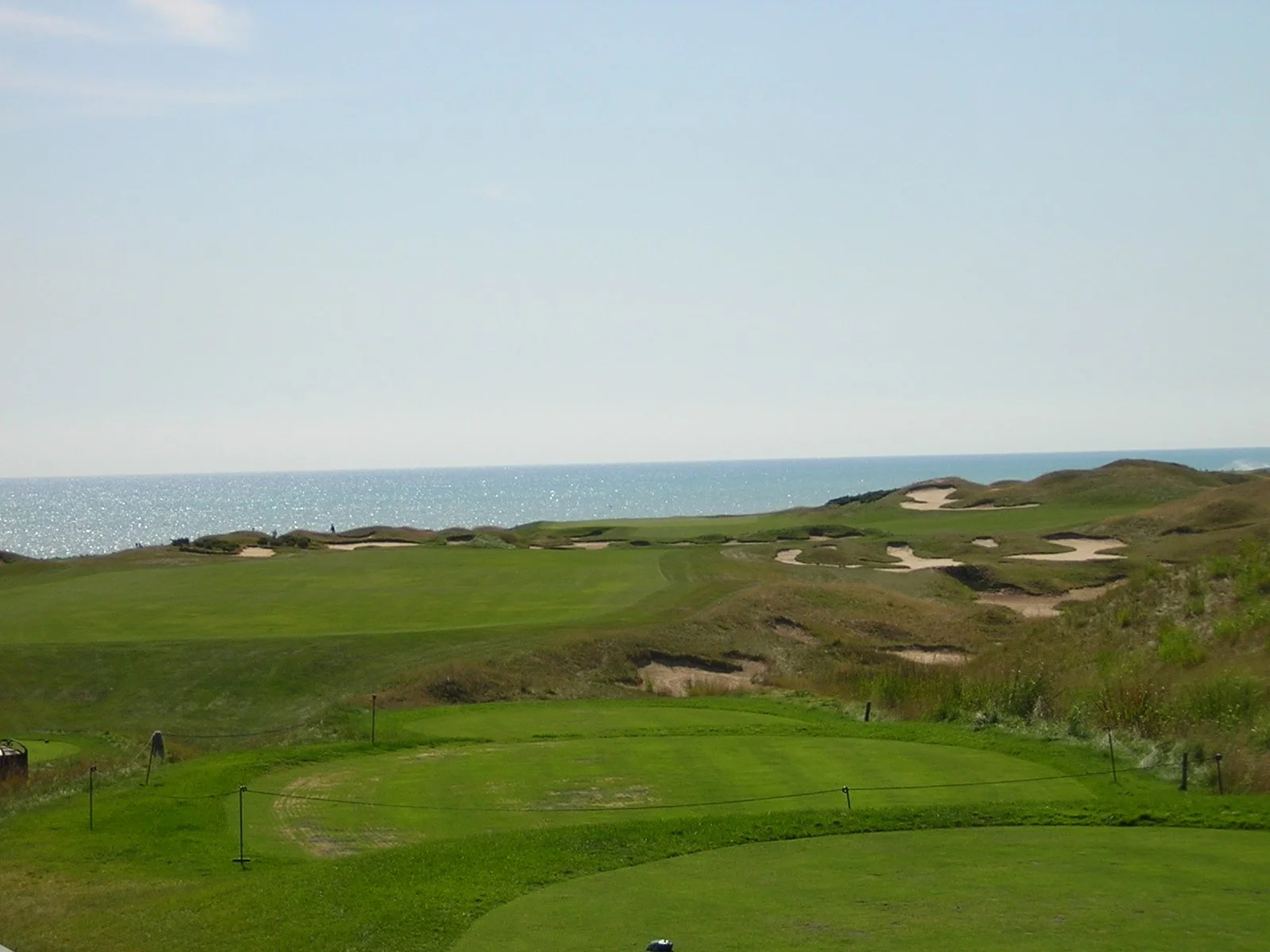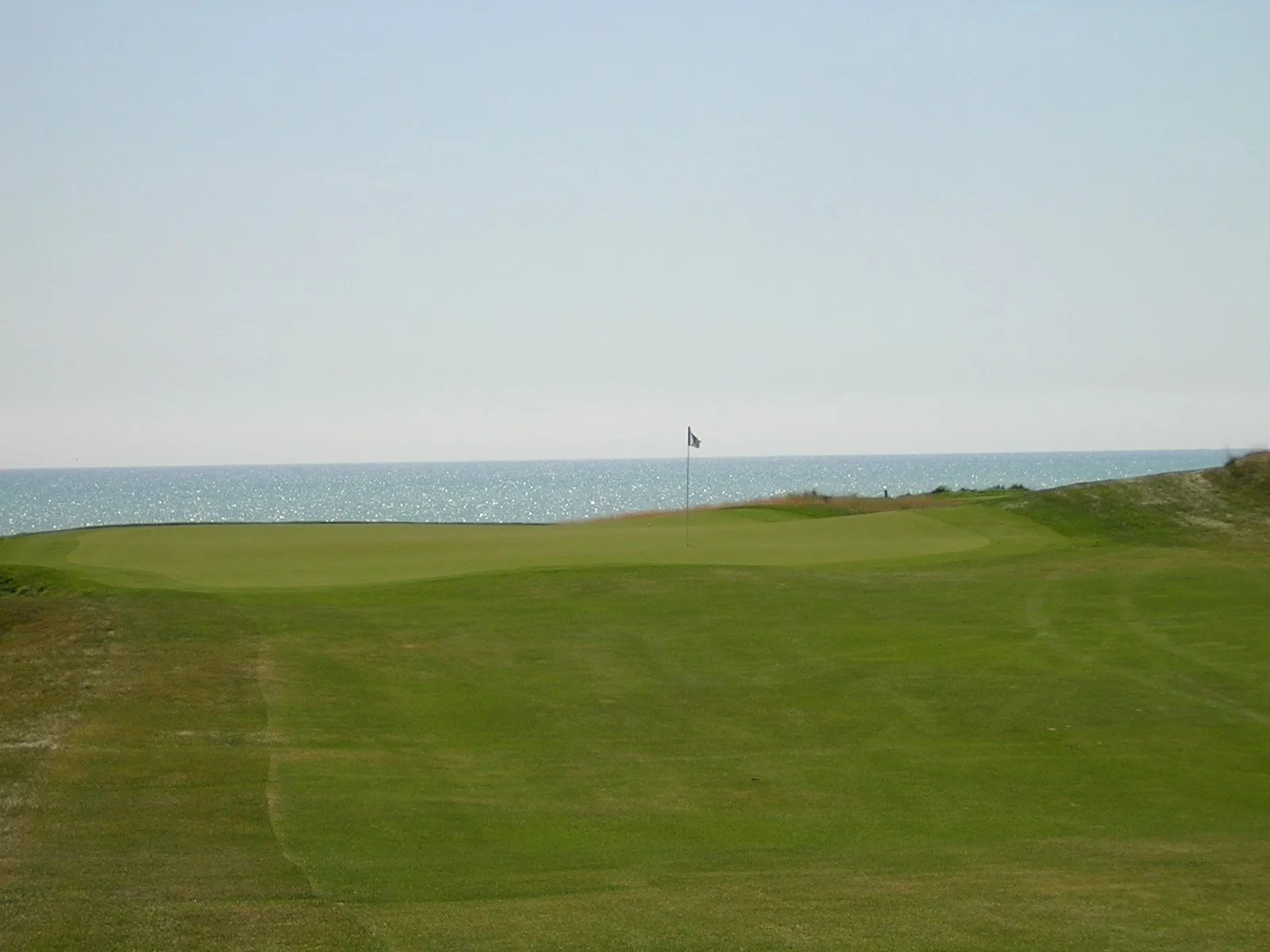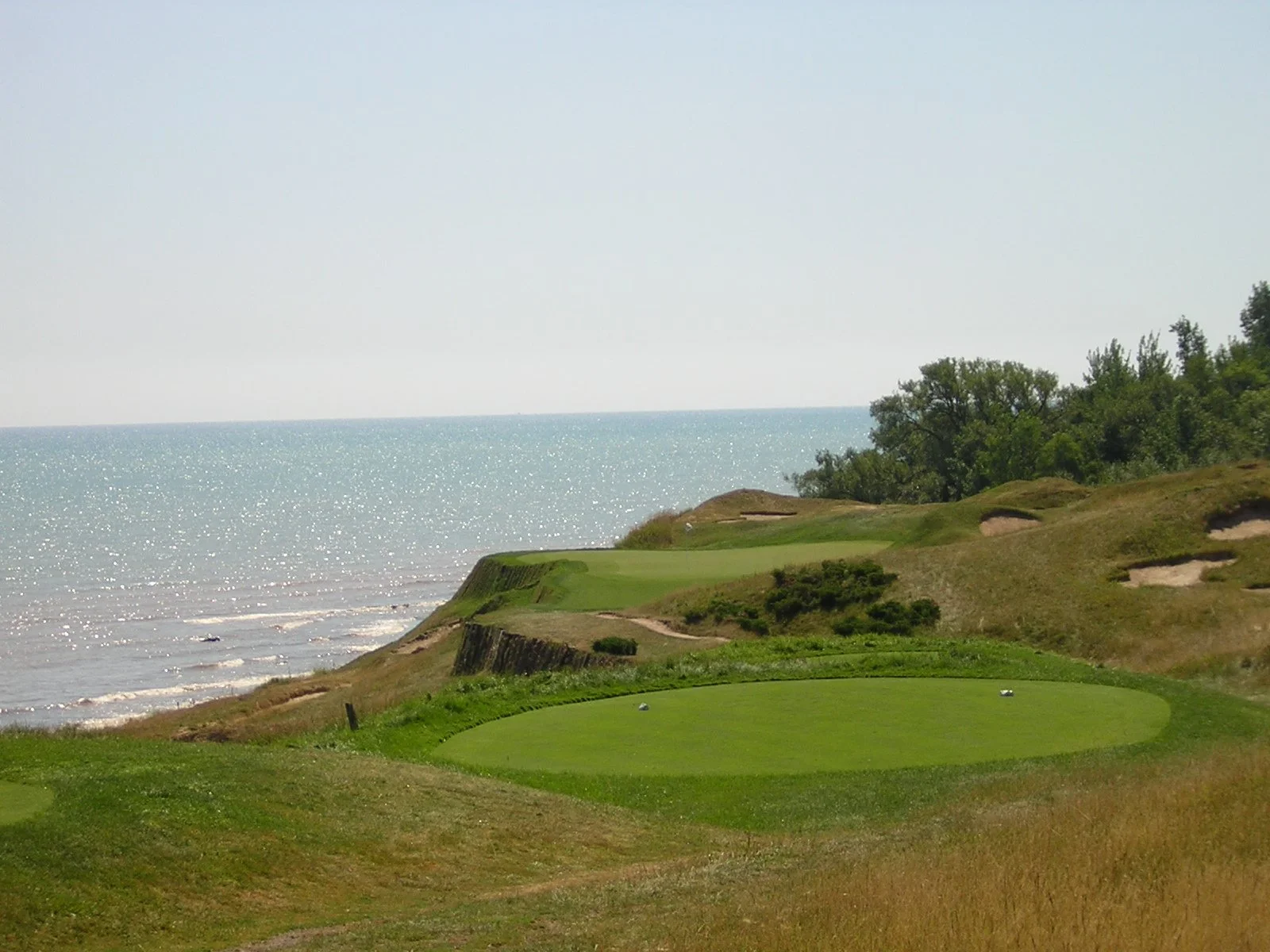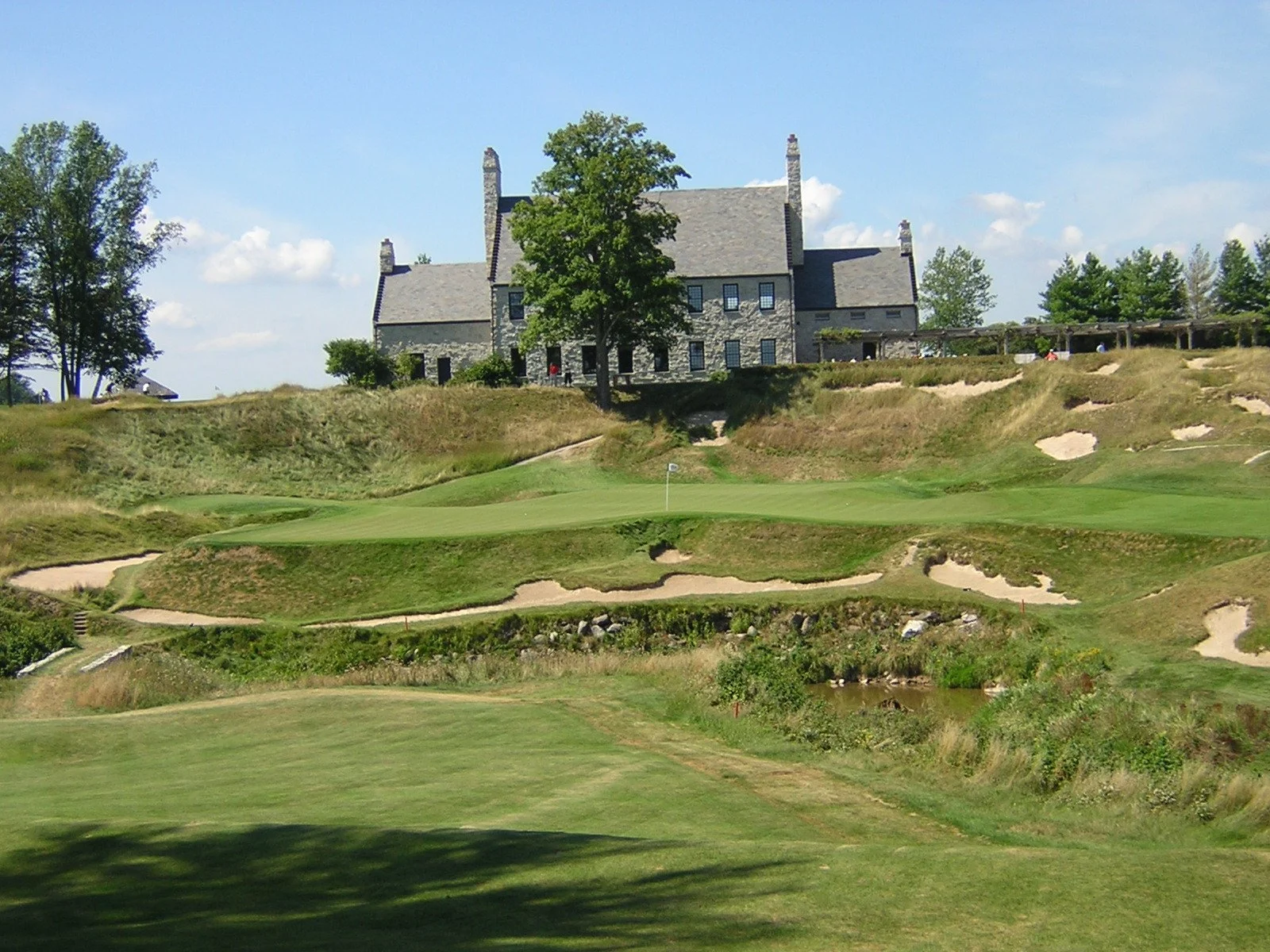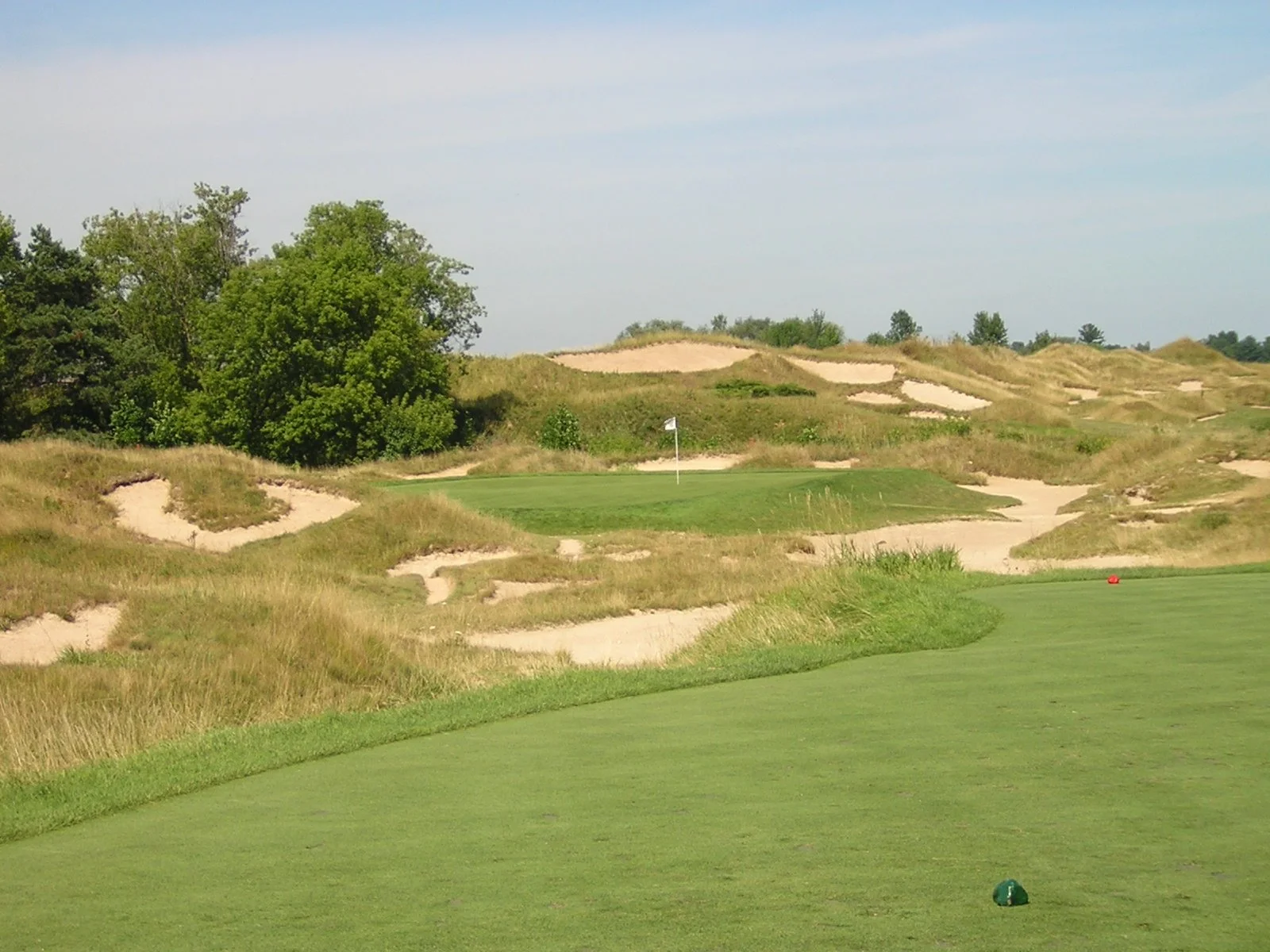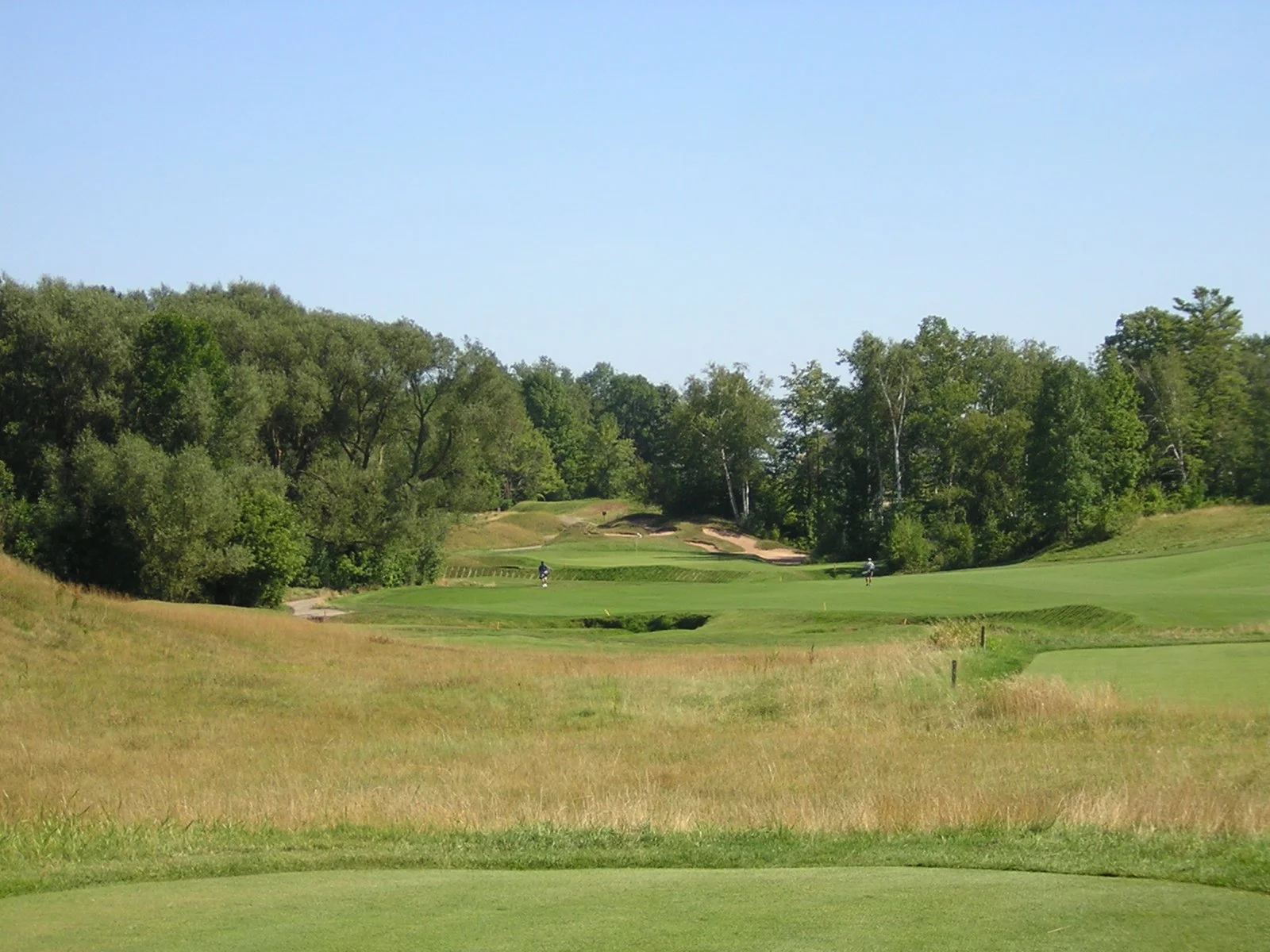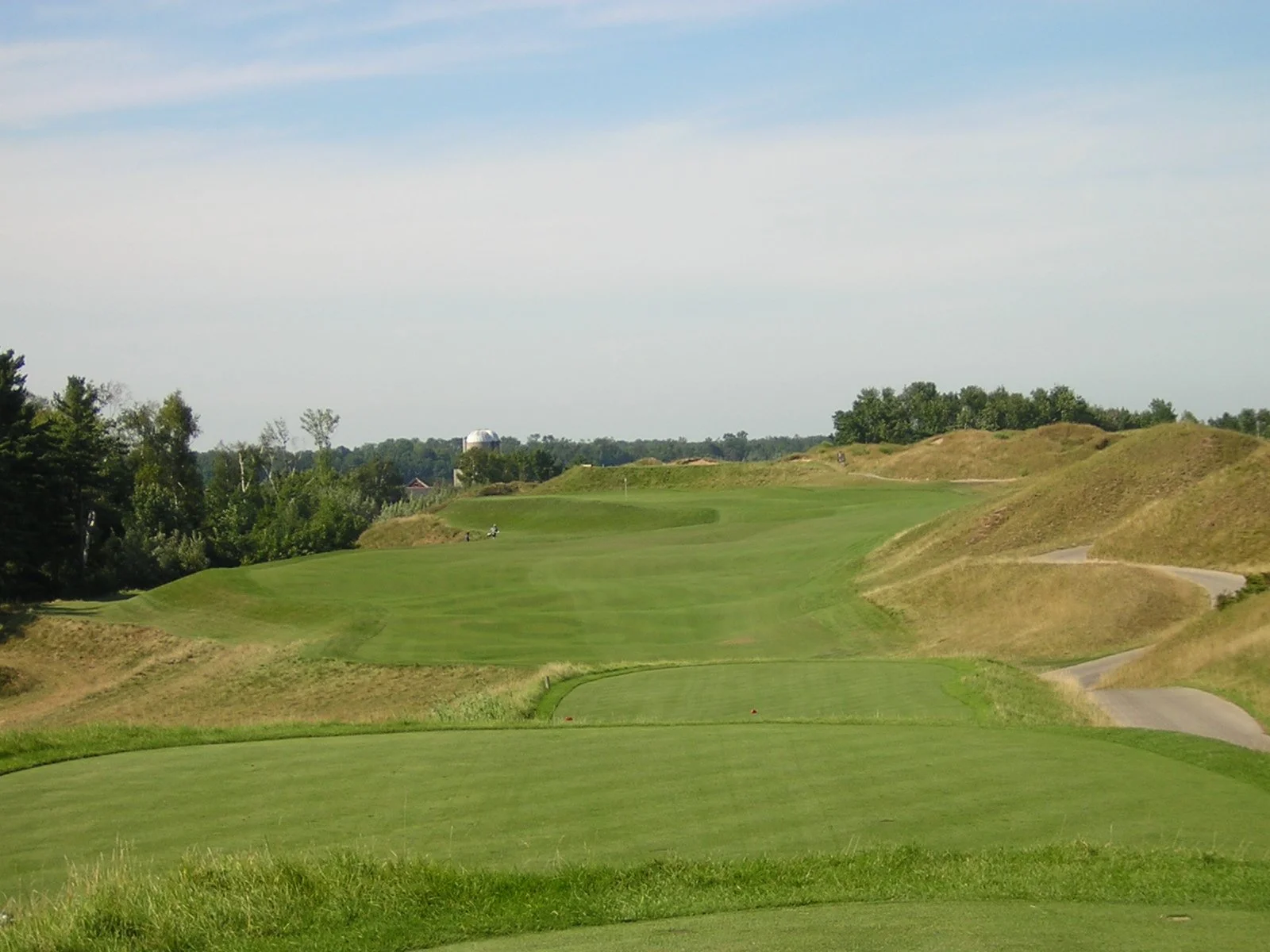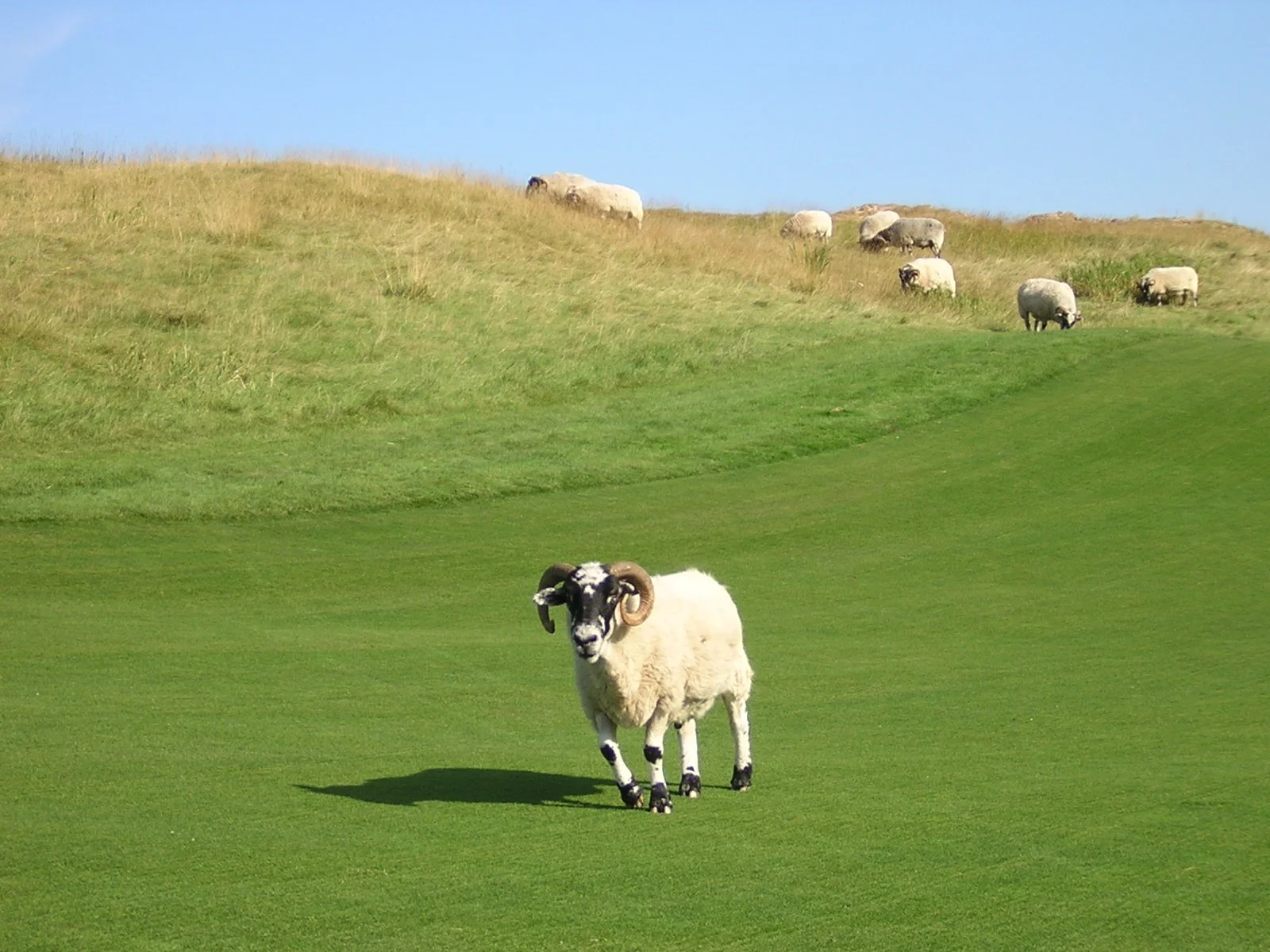WHISTLING STRAITS (STRAITS/IRISH COURSES)
Straits Course Architect: Pete Dye (1998)
Year Opened: 1998
Location: Haven, Wisconsin
Slope: 146. Rating: 78.1
Par: 72
Yardage: 7,514
Hole-by-Hole: 1 - Par 4 408 Yds 10 - Par 4 361 Yds
2 - Par 5 593 Yds 11 - Par 5 618 Yds
3 - Par 3 181 Yds 12 - Par 3 143 Yds
4 - Par 4 493 Yds 13 - Par 4 404 Yds
5 - Par 5 598 Yds 14 - Par 4 373 Yds
6 - Par 4 355 Yds 15 - Par 4 518 Yds
7 - Par 3 221 Yds 16 - Par 5 569 Yds
8 - Par 4 507 Yds 17 - Par 3 223 Yds
9 - Par 4 449 Yds 18 - Par 4 500 Yds
Par 36 3,805 Yds Par 36 3,709 Yds
Key Events Held: PGA Club Professional Championship (1999),
PGA Championship (2004, 2010, 2015),
U.S. Senior Open Championship (2007),
Ryder Cup (2021), U.S. Amateur (2028), U.S. Junior Amateur (2033).
Awards Won: Ranked #3 by Golf Magazine - Top 100 You Can Play (2008),
Ranked #1 by Golf Magazine - Best Courses Near You (2008),
Ranked #1 by Golf Digest - Best in State (WI) (2005-08),
Ranked #24 by Golf Digest - Top 100 in America (2007-08),
Ranked #1 by Travel + Leisure - Best Resort Course (2006-08),
Ranked #1 by Golf Week - Best Public Access Courses (2006-08),
America's Top Golf Courses - Zagat Survey (2006-08),
Rated 5 Stars by Golf Digest - Best Places to Play (2002-08),
Best Course in Midwest by Travel + Leisure Golf (2008),
#3 by Golf Magazine - Top-50 Greatest Courses last 50 years (2009)
Irish Course Architect: Pete Dye (2000)
Year Opened: 2000
Location: Haven, Wisconsin
Slope: 142. Rating: 77.4
Par: 72
Yardage: 7,201
Hole-by-Hole: 1 - Par 4 400 Yds 10 - Par 4 398 Yds
2 - Par 4 372 Yds 11 - Par 3 208 Yds
3 - Par 3 147 Yds 12 - Par 4 413 Yds
4 - Par 4 489 Yds 13 - Par 3 183 Yds
5 - Par 5 570 Yds 14 - Par 5 564 Yds
6 - Par 3 160 Yds 15 - Par 4 479 Yds
7 - Par 4 372 Yds 16 - Par 4 474 Yds
8 - Par 5 555 Yds 17 - Par 4 375 Yds
9 - Par 4 484 Yds 18 - Par 5 558 Yds
Par 36 3,549 Yds Par 36 3,652 Yds
Key Events Held: Palmer Cup (2005).
Awards Won: Ranked #68 by Golf Magazine - Top 100 You Can Play (2008),
Ranked #4 by Golf Magazine - Best Courses Near You (2008),
Ranked #4 by Golf Digest - Best in State (WI) (2007-08),
Ranked #1 by Travel + Leisure - Most Underrated Course (2006-08).
Ranked #5 by Golf Week - Best Public Access Courses (2006-08).
Website: www.destinationKohler.com, www.akohlerexperience.com
HISTORY: "I should say this with some degree of modesty. But in my lifetime I've never seen anything like this. Anyplace. Period," commented Pete Dye in the Spring of 1998, just prior to the opening of the Straits Course.
Dye was given 560 acres of flat wasteland adjacent to one of the Great Lakes, and told to design the impossible. Wanting to create the unimaginable, visionary and plumbing magnate Herbert V. Kohler enlisted legendary golf architect Dye to transform an old airfield into a golfing destination in the middle of nowhere.
"Pete Dye has always made the most of the glorious possibilities that the land affords. He is nature's best collaborator and this time, he has truly outdone himself," said Kohler on the completion of the course.
Located on the western shore of Lake Michigan, Whistling Straits is a technological marvel. This is what can happen when you're given two miles of coastline and an unlimited budget, not to mention bulldozers and truckloads of sand and plenty of imagination. Think about it, 13,126 truckloads of sand, that's 800,000 cubic yards!
Lake Michigan actually comes into play on eight holes, and the water is in full view on the entire course. In fact, it's like playing on the ocean. Dye did not hold back. He formed bluffs and massive sand dunes, in fact, the 15th hole has an elevation change of 80 feet. Natural fescue adorns the fairways, in-place of the usual Bentgrass, and the courses are framed by over 1,000 bunkers.
To create this masterpiece into a traditional, links-style venue, Dye and Kohler even added stone bridges and sheep. That's right...sheep. When the course opened, six Scottish Blackface sheep were brought in to meander freely around the courses, just as they would have back in time, during the origins of the game. Currently, well over 40 roam the courses throughout the day. In fact, don't be surprised to see them walking the fairways with you during your round.
Offered Kohler, "The recreational result is what you see here today...sandy wastes which Pete and the winds have fashioned into magnificent dunes, knolls, hollows, and gullies. There are glorious elevated tees; broad fairways blanketed with a thick, close-growing mixture of fescue grasses. Solitary wind-warped trees and tumbling sandy cliffs add a severe, almost desolate kind of beauty. The course offers a succession of spectacular views, each more remarkable than the last. The design of Whistling Straits pays homage to the origins of the game." It seems Mr. Kohler was pleased with the result.
Just one year after opening, the Straits Course hosted the PGA Club Professional Championship. Jeff Freeman shot rounds of 70-70-72-75 for a 1-under-par total of 287, as he defeated three players by two shots. The real winner was the golf course, as the Straits played to a scoring average of 75.14. For the week, only six players broke 70, with the low round a five-
under-par 67 in round two by Terry Mauney. Upon completion of the event, Freeman commented, "This is a great golf course that Pete Dye has built. I guess he doesn't want anyone to shoot low scores on it."
In 2004, Vijay Singh won his third career major, as he defeated Chris DiMarco and Justin Leonard in a playoff, as the Straits Course hosted its first major championship, the PGA Championship. "What a great monster you created here," commented Singh after winning. "I can't wait to come back and play another tournament here."
Two shots back after day one, Singh moved into first with a second-round 68, tying Leonard at nine-under par. A third-round 69 gave Singh a one-shot lead heading into the final day. Paired with Leonard, Singh struggled throughout the round going out in three-over, as Leonard took the lead. With three holes remaining, the 1997 British Open champ was two ahead of Singh and DiMarco. Leonard, however, missed a five-foot par putt on 16 and a 12-footer on 18 to finish his round at 75 and regulation at 280.
DiMarco, who was the only player in the field to post all four rounds under par, had a chance for birdie and the win on the last, but missed short from 12-feet. DiMarco closed with back-to-back 71s on the weekend to tie Leonard. DiMarco had moved into a tie with Leonard on the back-nine, however bogeys on 15 and 16 pushed him back. After a string of eight consecutive pars, Singh,
who had 34 putts the final day, bogeyed 15, but was able to par the final three holes to join the playoff.
The three-hole aggregate-score playoff started on the 10th, and Singh wasted no time in getting started, nearly driving the green and making his only birdie of the day from six-feet. Both DiMarco and Leonard made par and trailed by gone. On the par-three 17th, Singh's three-iron finished five feet away, however the Fijian was unable to convert and his competitors remained one behind with respectable pars. On the closing hole, Singh knocked his utility wood 45 feet from the hole, while both Leonard and DiMarco missed the green. Singh completed the victory with a two-putt, as he tapped in from one foot for his first major championship since the 2000 Masters.
The Irish Course hosted the Palmer Cup in 2005, as the American squad knocked off the European team, 18-6. The event is a Ryder-Cup style competition between collegiate golfers from the United States and Europe. The U.S. team was captained by Buddy Alexander and featured current PGA Tour players, J.B. Holmes and Jeff Overtone and Nationwide Tour player Spencer Levin. Tied heading into the eight singles matches, the Americans captured the first six
en route to victory.
The United States Golf Association made its first foray into the Straits course with the 2007 U.S. Senior Open Championship. In one of the most exciting and frustrating championships in history, Brad Bryant completed an improbable comeback to win by three shots over Ben Crenshaw.
Trailing Tom Watson by five shots heading into the final round, Bryant carded a four-under 68, the low round of the day to overtake a struggling Watson and win his first USGA Championship.
After opening with rounds of 70-66, Watson seemed in control, and even after a third-round 73, Watson still held a three stroke lead over Loren Roberts. In Sunday's final round, Watson reached nine under par and was four clear of Bryant and five ahead of Roberts with just eight holes remaining. Watson's game began to fall apart, as he double-bogeyed 11 and back-to-back bogeys on
12 and 13 saw his lead disappear. Another double-bogey on 15 and a closing double on 18 finished Watson, as he finished with 43 on the back nine for a six-over-par 78 to place fourth.
Crenshaw started the final day six shots back in 12th, but managed a closing 70 to finish alone in second. With winds gusting throughout the day, Bryant was one of only two players to break 70, and the only player in the field to post all four rounds of par or better. It wasn't until the par-five 16th that Bryant took the lead with a two-foot birdie. Bryant, who led the field in greens in regulation all week, knocked his tee shot to six feet at the 17th. He missed the birdie try, but tapped in for par. At the 18th, Bryant two-putted from about 30 feet to close out the win.
Once again the course proved to be very difficult, especially the closing 18th that played to a scoring average of 4.589 with just 23 birdies. Overall, the Straits course scoring average was 75.828, with 16 of 18 holes playing over par for the championship.
It came as no surprise that the PGA of America made return trips to Whistling Straits in 2010 and 2015 for the PGA Championship and in 2021 for the Ryder Cup.
Matt Kuchar opened the 2010 PGA with a five-under-par 67 to grab the early lead, with four players just one shot back. Kuchar continued his impressive play with a second-round 69 for a one-shot lead over Nick Watney, with Jim Furyk and J.B. Holmes two behind. Watney moved into first with a 66 on Saturday for a one shot lead over Dustin Johnson and Rory McIlroy. Martin Kaymer, Jason Day and Liang Wenchong, who shot a course-record 64, were tied for fourth. Kuchar could do no better than 73 and faded back. Seven players held at least a share of the lead on the final day. Watney struggled to an 81 and never threatened. Steve Elkington made a late run, tying for the lead after a birdie on 16, but back-to-back bogeys pushed him to fifth. Bubba Watson shot a final round 68, which included a birdie on 16 to tie for the lead. McIlroy, despite shooting 72, had a chance to tie for the lead, but missed a 15-foot birdie on the last to finish third. Johnson made back-to-back birdies on 16 and 17 for a one-shot lead, but bogeyed the last to fall into a tie. However, it was apparent that he grounded his club in a fairway bunker on the final fairway and was given a two-shot penalty and tied for fifth. That left Kaymer, who sank a 15-footer for par on the last to tie Watson. The player was held on the 10th, 17th and 18th holes. Watson birdied the 10th, however Kaymer evened the score on 17 with a birdie of his own. Both players struggled on 18, however Kaymer sank a two-foot bogey putt for the win, as Watson made double-bogey.
In 2015, Jason Day played four brilliant rounds of golf, shooting all four days in the 60s to post a three-stroke win over Jordan Spieth. His four-day total of 268, 20-under-par set a major championship scoring record. Dustin Johnson, trying to make amends from 2010, shot a final round of 69 to tie for seventh.
Originally scheduled for 2020, the Ryder Cup was postponed due to the pandemic and was held the following year at Whistling Straits. Fielding its youngest team ever, the United States dominated play the first two days, boasting an 11-5 advantage heading into singles play. Sunday’s singles action proved to be more of the same, as the USA won seven of the matches and tied two for an 8-4 advantage and an 19-9 thrashing of the Europeans. Dustin Johnson, Patrick Cantlay and Collin Morikawa were the leading point getters for the United States. Johnson was a perfect 5-0, while Cantlay and Morikawa recorded 3 1/2 points each. Jon Rahm led the Euros with 3 1/2 points.
REVIEW: STRAITS COURSE - Bending from right to left, the opening hole on the Straits Course gives the player his first glimpse of mighty Lake Michigan, not to mention the myriad bunkers strewn across the course. Hitting to the right-center fairway, avoiding the dunes and bunkers, will leave the best angle of approach to a well-guarded green. The 31-yard-long putting surface is fairly benign, but missing right and long will leave a difficult up-and-down from a
shaved chipping area. Oh, and by the way, the hole can be stretched to 491 yards.
The second longest hole on the course, the par-five second is a robust 592-yard monster, nicknamed Cross Country. By now, the player has figured out that missing fairways on the Straits Course will prove to be hazardous to your score. With bunkers running up and down both sides of the landing area, you'll need to be spot on with your tee ball. This three-shot hole requires an adept
layup, especially the closer you get to the hole, as the fairway narrows dramatically. Your third will be slightly uphill to a narrow green with deep bunkers below the hole to the left and a runoff swale to the right.
The first of four outstanding par threes that run alongside Lake Michigan, the third is all carry over sand and dunes to one of the longest and most undulating greens on the course. Miss left and you'll end up swimming with the fishes. When the wind is up and the pin is back-left, watch out.
Rated as the hardest hole on the course, the fourth is a par four that can play as short as 348 yards and as long as 500. Hanging above the lake, you'll need to bust a drive down the right-center, avoiding the disaster that looms below. A long iron or fairway metal will be required to reach a slightly elevated green that stands perched above the water. Make par here and you're better than most.
Aptly called the Snake, the fifth, which moves inland, wraps around water and dunes as it plays west towards Kohler, then north to Green Bay and west again. A big tee shot can set up a possible chance to get home in two, but very risky, as water fronts the putting surface. Laying up is no bargain either, as the landing area is quite narrow, with water left and dunes right. If
successful, just a wedge will remain to the long and narrow green. Very tempting, but use your head.
One of only three par fours under 400 yards, the sixth is a dogleg right that requires pinpoint accuracy. Three-metal is a nice play off the tee, but be wary of the pot bunker on the left side of the fairway. Any shot missed to the right off the tee will result in a difficult lie in either sand or scrub and trust me, the scrub is horrible. Your second will be just a wedge to a very undulating and narrow green that runs left to right. Miss short and you'll end up in one of several deep pot bunkers.
Back along the shoreline of Lake Michigan, the seventh is a beautifully framed par three that reaches 214 yards. There's no crime in bailing out left, as playing from the beach is no picnic. A dozen or so bunkers protect the left side of the green, which is 42 paces in length. A back-right pin with the wind howling makes this one of the most feared holes on the course.
With the waves crashing along the shoreline, you'll have a hard time staying focused on the task at hand, carrying a couple of hundred yards of sand and waste area to reach the landing area on the 462-yard eighth. Several dozen bunkers dot the landscape on this par four, not to mention the severe drop-off towards the water on the right. Playing slightly downhill towards the green, a mid-iron should suffice, depending of course on the pin placement of this whopping 47-yard-long putting surface. The tiered green runs from front to back and may be difficult to hold when the pin is back.
The closing hole on the front nine heads back towards the clubhouse and requires a tee ball struck towards the left side of the fairway, as it will kick towards the right. Too far down the right might leave a blocked second shot due to a tall tree at the 100-yard mark. Just a short iron should remain for your downhill approach to another well-guarded green. Sand dunes and bunkers on the left, and Seven Mile Creek on the right, make for an intimidating target.
Playing uphill from tee to green, an aggressive play with driver should be the club of choice on the short, par-four 10th. A deep fairway bunker looms larger than life in the center of the landing area, but with driver in hand, you should be able to clear disaster. The club to the green is quite severe and might require a little extra zest to reach the plateau. Only 28 paces in length, the putting surface is quite slick from back to front and any shot short of the green will run back down the fairway.
From short to long, the 11th is the Grande Dame at the Straits and garners the name "Sand Box." Try adding up the bunkers up and around this par five and you'll lose count. The drop-off to the right can spell doom, so play down the left side and make this a true three-shot hole. Although it narrows towards the green, a layup down the right will leave around 100 yards in. Slightly uphill to an elevated putting surface, you'll need to be quite accurate, as the green is just 23 paces and surrounded by a shaved swale. As if the length of the hole wasn't hard enough.
Back along the water, the par-three 12th is the shortest and probably the most difficult to attack, despite the length of the green. Just 166 yards, the greenskeeper can make mice out of men on this gem. With the multi-tiered putting surface perched above the water, the man in charge can be really cruel with a back-right pin, where there's just a few yards of space. A drop-off of 40 feet to Lake Michigan will snare plenty of balls that are just off line, so play to the fat of the green and trust your putter.
One of the few modest holes on the course, the 13th is just 403 yards and bends to the right towards the green. Plenty of fairway and rough to the left, so if you must bail out that's the play, as another severe drop to the right will end up in the sandy dunes or worse, "The Lake." A short iron should be the club of choice to the downhill green that sits incredibly close to the water. The narrow putting surface features several humps and bumps as it cants to the right. At second glance, not that easy, is it?
The sharp, dogleg-left 14th requires brain not brawn in an attempt to conquer. Fairway metal or long iron off the tee should set up a very short iron approach to the slightly elevated green. Miss left off the tee and you'll have a sandy, blind approach, while a right mistake can leave an awkward lie off the dunes. The putting surface is long and undulating as it slopes from back to front. This hole can be had, but you need to be precise.
The 15th starts a final stretch to the clubhouse of spectacular proportions. Maxing out at 518 yards, this par four -- yes, par four -- is very awkward to the eye, as you must adjust your line of sight to the fairway towards the left. Even with a mammoth blast, you'll need a fairway metal or more to reach the green. Sand surrounds most of the S-shaped landing area, so pick your line and go with...you know. There's nothing to be ashamed of making a bogey, at least that's what I keep telling myself. When Vijay Singh captured the 2004 PGA Championship, he made two pars and two bogeys, as the hole proved to be the most difficult for the week, averaging 4.35 shots.
The final par five with a real chance to yield a birdie, the 16th is a reachable 535-yarder that finishes overlooking Lake Michigan. An ample fairway for mere mortals, the landing area tightens for the big hitters in their attempt to get home in two. With sand dunes and the dropoff towards the water lurking left, you would be wise to hit the fairway. Your second shot plays slightly uphill to the green or if you're laying up, a tight finger of a fairway. The putting surface is long and elevated, making your approach difficult to get close.
Difficult, demanding, intimidating and downright beautiful, that's what's in store as you stand on the tee of the 17th. The longest and most difficult of the par threes, this sensational one-shotter requires cojones! Hugging the Lake Michigan coastline, you'll need to bust anywhere from a long iron to a driver depending upon the conditions. The 30-40 foot dropoff is enough to shake any player's confidence. The putting surface is large enough where you can bail to the right, but a back-left pin can be daunting. How tough is the 17th? During the 2004 PGA Championship, the hole played to a scoring average of 3.1438 with just 20 birdies in four rounds. Although he tied for 68th, Robert Gamez aced the hole they call "Pinched Nerve" in round two with a five-iron.
What's in a name? How about the closing hole on the Straits Course being called "Dyeabolical." At 500 yards from the back tee, your only hope is for the wind to be at your back. Another big drive is needed just to reach the fairway to have any shot at getting home in regulation. Sandy brush and dunes are in full view down the left side, so play out toward the right, elevated fairway. If you fail to accomplish this task, you have an option of playing left to a new landing area or right to an adjacent fairway (I went left). A long iron or fairway metal will remain to a humongous green that sits down in a bowl fronting the clubhouse. With a forced carry over sand, scrub and Seven Mile Creek, you might want to take an extra stick to better your chances. Both DiMarco and Leonard had chances to win in 2004 on the final hole, but both missed putts, while Singh parred the last in regulation and in the playoff for the title.
IRISH COURSE - If you think playing the Irish Course is a step down from the Straits, you're sorely mistaken. You'll certainly find this out on the first tee, as the opening hole plays 400 yards long and uphill through the green. A generous fairway gets you started on the right track, but you'll need an extra club or two to reach the angled left green. A half-dozen deep bunkers guard the left side of the putting surface, which stretches 34 paces. Watch out for a back-left pin. If that's the case, play towards the right and trust the short game.
A beautiful, dogleg-left par four, the second requires smarts, not brawn, off the tee. Wrapped around a lake and just 372 yards long, this gem needs just a fairway metal or hybrid off the tee to set up an easy approach to a wide, but narrow, green. The undulating putting surface is protected in front by a pair of bunkers, while one deep trap lurks in the rear. When the weather is up, this hole can be a real test.
Although the third is rated as the easiest on the course, don't be lulled into a false-sense of security. The green is wide and fronted by water and a railroad-tie bunker made famous by the designer that stretches of 35 yards. Despite its short distance, you need to be spot-on or you'll find plenty of
trouble.
Easily one of the most difficult holes on the course, the fourth is the longest par four on the Irish, a whopping 489 yards. Doglegging hard to the left, the key is a tee shot that must draw from right to left, avoiding the huge waste-area trap that runs down the entire left side of the fairway. A mid-to-long iron will remain to a very small target, protected by sand dunes left and an enormous trap right. The putting surface is slick, two-tiered and runs from back to front. This monster is aptly named "Sandbanks."
Temptation could certainly replace "Devil's Elbow" as the name for the par-five fifth. From the back tees on this dogleg right, the big hitters will be chomping at the bit to cut the corner in efforts to reach in two. The problem is two-fold, as a huge, waste-area-styled bunker guards the dogleg, while further right are thick brush and deep trees. The smart player will go down the left side of the fairway and then layup short of the creek bed and crossing bunker. The split landing area can be reached, but its narrow strip makes for a difficult target. The green is very long and undulating with sand covering the entire left side. Watch out, this might be a day at the beach you
didn't want.
One of my favorite par threes on the course, the sixth reminds me of the 10th at Prairie Dunes in Kansas. This stellar hole is completely surrounded by sand and dunes, making it an island green. The putting surface is quiet and could produce a possible deuce, that is of course if you hit the green.
The short, dogleg right seventh can be a birdie or double-bogey waiting to happen, depending upon your tee shot. Just 372 yards in length, the key is hitting the rolling, wide fairway. For the big hitters, three-metal or less works best, but for us mortals, a driver can suffice. Your approach shot with a short iron is slightly uphill to a kidney-shaped green. Avoid the right side of the hole, as a creek and trees will swallow up anything close. Of course the deep pot bunker, short-left is no bargain either.
The eighth is more of a three-shotter than most par fives, as this monster requires strategy and finesse. Your tee shot must carry almost 200 yards just to reach the landing area and needs to be placed down the left side. Two humongous bunkers down the right sit well below the fairway and must be avoided. Your second shot, playing slightly uphill, must clear the ever-present creek to reach the layup zone. Two fairway traps around the 100-yard mark will dictate the approach. Your third shot is straight uphill to a slim, slick green that runs hard to the front and is guarded by sand short. Making birdie won't be easy, neither will par.
Another double-carry hole, the ninth is another monster par four of 484 yards in length. From the back tees you'll need a howitzer to carry the crossing creek to the upper fairway! The lower landing area is accessible, but it will leave a longer second to a long and difficult target. Not only will your approach be over 200 yards, but you'll have to splice your shot in between trees and over the creek once again. A rarity on the Irish, this hole features the least amount of sand on the course, but plenty of trouble.
Playing straight uphill, the 10th swings slightly to the left and plays every bit of its modest 398 yards. Use driver and play down the right, avoiding the severe drop-off on the left, not to mention sand and thick rough. A medium iron should remain to an elevated green that allows only a glimpse of the flag. Remember, take an extra stick to get home or you'll roll back down the fairway. The putting surface is long and slick, so be careful. The best offense is a good defense.
Another sensational par three, the 11th can reach 208 yards from the black buttons. Sand covers the entire right side of the monstrous green, the second longest on the course at 49 paces. So you would figure with all this trouble right, that missing left would be an OK bailout. Wrong. Two deep bunkers, hidden by mounding, lurk in the distance. The traps are so deep that even Shaquille O'Neal couldn't see out of them. Even hitting the putting surface is no guarantee of par. Take what you can get and move on.
The only hole on the course without sand coming into play, the 12th is a modest, straightaway par four. The fairway is very generous and sloping from right to left. Try to stay on the right side for the best angle to the green. The putting surface is long and lean and guarded on the left by a deep, grassy drop-off.
The final par three on the course is the 183-yard 13th. This beaute features a 50-yard-long green that's partially hidden on the right. Tall mounding and bunkers in the rear provide an excellent target, but are hazardous to your score. It's all carry to the green, so get the correct yardage from your caddie and let it rip. At 14,000 square feet, you'll see plenty of three putts.
From the back tees, you'll need to carry your drive over 200 yards to reach the fairway, otherwise, a huge waste-area bunker, which also runs down the left, will snare your errant shot. It's risky and highly unlikely that you'll reach this par five in two, as the hole plays uphill from the fairway. The
prudent play would be down the right side, which will leave a 100-yard shot to the green. Be mindful of the creek that runs along the left and splits the landing area. Your third will be to an elevated green fronted by numerous pot bunkers. The blind putting surface features a great backdrop. Rumor has it that Dye buried a bus and train cars underneath mounds and mounds of dirt.
Again, Dye has saved the best -- or what some would say, the hardest -- for last. Starting with the rugged, dogleg-right 15th, this stretch of holes rivals the Straits Course. At 479 yards, this par four requires another long carry over grassland just to reach the fairway. Playing left is the safe move,
however this will leave a very long approach to a lengthy green. From the right, you'll need to carry more dense rough and several bunkers that front the angled green. A back-right pin can be dastardly, especially with a freshened wind.
Playing uphill to the fairway, the 16th is another long par four that features water lining the left side, not in view from the tee. The right is no walk in the park either, as rough and scrub brush make for a difficult second. The fairway falls off hard to the right as you near the green into a cavernous bunker, and a deep pot bunker guards the putting surface on the left, so your choices are minimal. The green is quite slick from left to right, so stay below the hole for your best chance at par.
Although the 17th is one of the shorter par fours on the course, it certainly will test your mettle. With a lake to the left and sand dunes to the right, you'll have to be spot on with your tee shot or double-bogey is brought into the equation. Fairway metal or hybrid off the tee might the best play, even though the landing area is generous. Your approach from the fairway must cross the corner of the water to reach the narrow green. It makes for a pretty site, but six on the scorecard never looks good.
Heading for home, the 18th is another tough test -- this time, a 558-yard par five. The tee shot is a long carry over water to a big fairway with sand on the right. Left side of the fairway will give you the best option for your second. You'll have to decide wether to layup short of the crossing creek or
try to clear with a 200-yard-plus approach. The smart choice is an iron to the bottom of the fairway, leaving an uphill shot at the elevated green. Trying to clear the hazard will leave a difficult and blind approach to the large putting surface. Careful not to miss left of the short grass, as a deep bunker awaits well below the green. Any shot short and right will run back down the fairway, as the incline is steep.
FINAL WORD: I look back at my experience at Whistling Straits and get goose bumps. Playing two of the best courses in the country, on Lake Michigan with spectacular views, being treated like a movie star and walking where some of the greats of the game have crossed, is a once-in-a-lifetime encounter.
First of all, we have to start with The American Club, a three-story, three wing resort with guest rooms and suites totaling 237 and more than 21,000 square feet of conference space. The brilliant red brick throughout the buildings and the slate roofs give this Tudor-style structure its wonderful character. The dining is first-cabin, including the Immigrant Restaurant, a AAA Four Diamond Award establishment for 17 straight years.
But the real jewels of Kohler are the two phenomenal courses at Whistling Straits. Some have called the Straits Course as "Ireland on steroids." I have yet to travel to The Emerald Isle, but if it's anything like the Straits and Irish courses, than I'm in for a real treat.
Most people talk about the final holes at a course being some of the best on the layout, but with the Straits, the entire venue is as good as it gets. The walking-only course on the shore of Lake Michigan is, in a word, a masterpiece.
Framed by massive sand dunes and bluffs, the Straits Course offers views of the lake on all 18 holes, with eight holes snug up against the great body of water. The greens are massive at 7,500 square feet and with more than 500 bunkers and even more sand dunes, you're in for the ride of your life.
Caddies are required on the Straits and with the course stretching to almost 7,700 yards, you'll walk approximately 5 miles. Now don't get discouraged, there are five sets of tees starting at 5,400 yards, so choose the correct color and you'll have the time of your life.
The Irish Course is a wonderful complement to the Straits. Not as long as its partner, the Irish also boasts five sets of tees, ranging from 5,100 to 7,200 yards and yes, plenty of sand. Almost 2,000 trees were planted on the course, and although Lake Michigan is in view on five holes, it never comes into play. The Irish does feature plenty of water hazards, in fact, four streams snake through the course, not to mention a 10 1/2 acre lake on 16 and 17.
"The challenge for me was to create a second 18-hole course at Whistling Straits that would be comparable to the first course, not just a complement but of equal stature," said Dye.
Walking is preferred on the Irish, however carts are available for those who like cart-path only. Golf is a traditional game, so trust me when I tell you, take a caddie on both courses, you'll be glad you did. The greens are not as large as the Straits at 7,000 square feet, however the 13th hole boasts a
whopping 14,500 square foot putting surface.
The caddie program at Whistling Straits is something special. Each incredibly knowledgeable about the courses, yardage, greens and after a couple of holes, your game. What I really enjoyed was the fact that our caddie was right on with the reading of the greens, the history of the courses and his genuine honesty and kindness. Just ask for Brian Everatz the next time you venture to Kohler, trust me, he'll only add to the experience.
Most clubhouses nowadays are these massive 21st-century structures that look out of place, but not at Whistling Straits. Modestly designed, the clubhouse fits the landscape to a "T". A farmhouse if you will, stationed above the 9th and 18th holes of the Straits Course, with remarkable views of Lake Michigan.
The two-story structure features a full-stocked pro shop for both men and women, a dining facility with sumptuous fare (the Kobe Sliders are amazing), a second floor bar and lounge and a complete locker room. Let's not forget the five fireplaces strewn about and the rich dark, inviting colors that give the clubhouse its wonderful charm.
Although not as expensive as Pebble Beach, Whistling Straits is a pricey ticket. At $330 for greens fees, another $60 for the caddie, not to mention tip and a few sundries in the pro shop, you're looking at $500 for a round of golf. So what? It's worth every penny and then some.
Bring your friends, bring the wives, heck, go by yourself, you'll be glad you did. This one is a must destination for all parties concerned.
I will always remember walking 36 holes with my buddy Dave one glorious, August day at Whistling Straits. One of my finest days on a golf course, ever!

